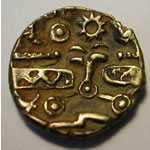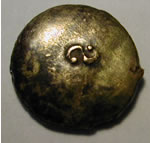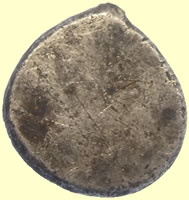

Metal detecting holidays in England with the World's most successful metal detecting club.20 years plus.
Twinned with Midwest Historical Research Society USA.
Celtic gold coins found here by tribe
Celtic coins were produced in two ways, conventionally described as struck and cast. Both methods required a considerable degree of technical knowledge to ensure successful results. The process of striking a coin began with the production of a blank. This was probably formed in a clay mould, but it is still uncertain how the metal alloy was placed in the mould. It probably wasn't poured in, which would make precise weight control difficult, but perhaps put into the mould in powder or nugget form, or possibly as sections from carefully measured ingots. Celtic dies were made of iron and/or bronze. They are extremely rare, since they were clearly carefully looked after while they were in use, and thus very rarely lost, and they were often used to destruction.. The quality of engraving on many dies is superb, and it is difficult to imagine how some tiny details were engraved on dies just a few millimetres in diameter. The engraving ability of the moneyers was matched by their control of the weight and alloy of the coinage. They were capable of producing thousands of coins deviating just a few milligrams each side of the intended weight, and they could make subtle alterations to the quality of the alloy, masking a decrease in the precious metal content. Most gold and silver Celtic coins also occur as plated forgeries. They were produced by coating a base metal core with gold or silver alloy before striking took place, either by dipping the core in molten alloy, or by hammering a thin layer of gold or silver around the core until it bonded with the base metal. Dies used for genuine coins were sometimes also used for plated examples; alternatively, dies could be faked by making a cast from a mould bearing the impression of a genuine coin, or by pressing a genuine coin into soft metal which was then hardened to form a die; sometimes the design of a coin was simply copied onto a new die, resulting in the reversal of the correct image. The production of cast coins required very different techniques. The cast coins from south-east Britain were produced by pouring molten alloy into a set of moulds joined by runners, which were broken apart when the metal had cooled. The breaks were not always neat and often parts of the sprue - the joining portion between the coins - remain attached to the coin itself. The earliest
examples of these coins in Britain have relatively fine images, which
were presumably made by pressing a coin into the mould. As this process
was successively repeated, the quality of the image being reproduced
became ever worse, eventually becoming a featureless blob
All coins on this page have been found by us and have been recorded by the Celtic Coin Index. They are available to view on the national Database The index contains 37925 Iron Age coins of which 23623 are provenanced and they have 37751 examples with images attached Comments against our coins are from Dr Philip de Jersey and John Sills Celtic coins starting coming into Britain around 150 B.C. and continued to be imported until after the Gallic War in 50 B.C. These imports were mainly gold staters and quarter staters minted Gallia Belgica (northern France) and copied from copies of gold staters of Philip II of Macedon. Some of the Gallo-Belgic coins came with immigrant settlers and others may have come with British mercenaries returning home after fighting the Romans in Gaul; but most of the imported coins were probably the result of cross-Channel trade, which included slave trading. The Greek geographer Strabo (ca. 60 BC to A.D. 20), whose name means “squint-eyed”, lists as the principal exports of Britain “grain, cattle, gold, silver and iron … also hides and slaves and dogs that are by nature suited to the purposes of the chase.”
|
Shortly before Julius Caesar's invasion of Britain in 55 and 54 BC, the Trinovantes were considered the most powerful tribe in Britain. At this time their capital was probably at Braughing (in modern-day Hertfordshire). In some manuscripts of Caesar's Gallic War their king is referred to as Imanuentius, although in other manuscripts no name is given. Some time before Caesar's second expedition this king was overthrown by Cassivellaunus, who is usually assumed to have belonged to the Catuvellauni. His son, Mandubracius, fled to the protection of Caesar in Gaul. During his second expedition Caesar defeated Cassivellaunus and restored Mandubracius to the kingship, and Cassivellaunus undertook not to molest him again. Tribute was also agreed. The next identifiable king of the Trinovantes, known from numismatic evidence, was Addedomarus, who took power c. 20-15 BC, and moved the tribe's capital to Camulodunum. For a brief period c. 10 BC Tasciovanus of the Catuvellauni issued coins from Camulodunum, suggesting that he conquered the Trinovantes, but he was soon forced to withdraw, perhaps as a result of pressure from the Romans, as his later coins no longer bear the mark "Rex", and Addedomarus was restored. Addedomarus was briefly succeeded by his son Dubnovellaunus c. 10–5 BC, but a few years later the tribe was finally conquered by either Tasciovanus or his son Cunobelinus. Mandubracius, Addedomarus and Dubnovellaunus all appear in later, post-Roman and medieval British Celtic genealogies and legends as Manawydan, Aedd Mawr (Addedo the Great) and Dyfnwal Moelmut (Dubnovellaunus the Bald and Silent). The Welsh Triads recall Aedd Mawr as one of the founders of Britain. The Trinovantes reappeared in history when they participated in Boudica's revolt against the Roman Empire in 60 AD. Their name was given to one of the civitates of Roman Britain, whose chief town was Caesaromagus (modern Chelmsford, Essex). The style of their rich burials (see facies of Aylesford) is of continental origin and evidence of their affiliation to the Belgic people. Their name was re-used as Trinovantum, the supposed original name of London, by Geoffrey of Monmouth in his fictitious Historia Regum Britanniae, in which he claimed the name derived from Troi-novantum or "New Troy", connecting this with the legend that Britain was founded by Brutus and other refugees from the Trojan War. |
The oldest celtic gold coins found here - unknown continental tribe
Celtic gold votive offering as ring money Gold ring money- 1st C BC 6.86g, 32mm L |
|
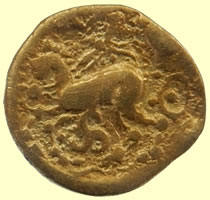 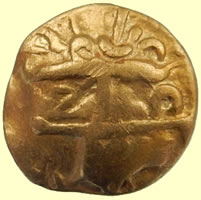 |
|
175 BC Celtic gold qtr stater Thanks to John Sills at the CCI for the ID 12mm,1.96g ABC 34 Defaced Die quarter with a left-facing obverse bust obscured by lines and a left-facing horse and rider on the reverse with triskeles below. This type was struck somewhere in the French/Belgian border region in the 2nd century BC by an unknown tribe and possibly dates to around 175 BC plus or minus a couple of decades either way. Used to be very rare, I listed 17 examples in my 2003 book but there are perhaps 30 or so known now |
|
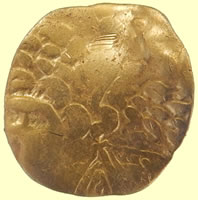 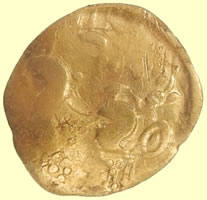 |
|
Mid 2nd C BC Gallo- Belgic A type Very interesting, very thin (1mm) like a medieval hammered gold- Celtic gold qtr gold stater - sent to PAS ID and recording 1.75g, 15mm Iron Age, mid-2nd century BC One of the earliest coins in Britain Iron Age, mid-2nd century BC One of the earliest coins in Britain This is a superb example of the Iron Age die-engraver's art. It also represents what is thought to be the first type of coin ever to circulate in Britain. They were probably made on the Continent in northern France or Belgium. Gold coins like this crossed over the English Channel, perhaps in trade or as gifts between high-ranking individuals. Some of them were eventually buried in coin hoards and not recovered by their owners. The owner may have died, or simply forgotten where they had put them. Alternatively, the coins may have been intended as permanent, sacred offerings to the gods. They are mostly found today by metal-detectorists, in locations throughout south-east England. Another one was found at Fenny Stratford near Milton Keynes. The design of the coin is, at several stages removed, descended from the Greek gold staters of King Philip II of Macedon (reigned 359-336 BC). The hair on the left-facing head has grown considerably, while the original two-horsed chariot on the reverse of the coin has been transformed here into a lively, abstract depiction of a horse surrounded by a large array of symbols. I.M. Stead and S. Youngs, Celts, British Museum Pocket Treasury (London, The British Museum Press, 1996) D. Nash, Coinage in the Celtic world (London, Seaby, 1987)
Mid 2nd C BC Gallo- Belgic A type
1.75g,14.57mm - Reported as potential hoard to museum
Mid 2nd C BC Gallo- Belgic A type
1.80g,14.30mm - Reported as potential hoard to museum
Mid 2nd C BC 1.74g,15mm
Mid 2nd C BC Gallo- Belgic A type 175 BC Celtic gold qtr stater - 1.68g, 14.85mm
|
|
45 BC to 25BC2010Exportspics Addedomarus - Trinovantian tribe Addedomarus (sometimes written Aθθedomarus on coins) was a king of south-eastern Britain in the late 1st century BC. His name is known only from his inscribed coins, the distribution of which seem to indicate that he was the ruler of the Trinovantes. He was the first king to produce inscribed coins north of the Thames, perhaps as early as 45 BC, although some estimates are as late as 15 BC. He seems to have moved the Trinovantian capital from Braughing in Hertfordshire to Camulodunum (Colchester, Essex). For a brief period (ca. 15-10 BC) he seems to have been supplanted by Tasciovanus of the Catuvellauni, who issued coins from Camulodunum at that time. Addedomarus then appears to have regained power and reigned until 10-5 BC, when he was succeeded by Dubnovellaunus. |
|
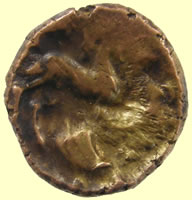 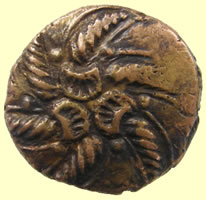 |
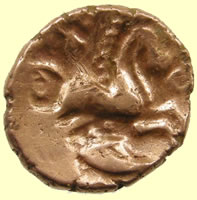 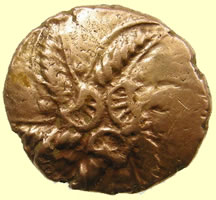 |
17.54mm,5.50g |
18.27mm, 5.47g |
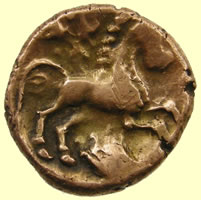 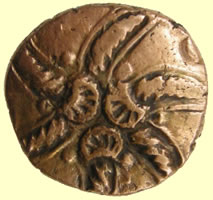 |
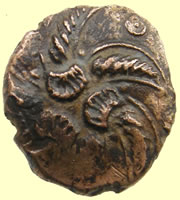 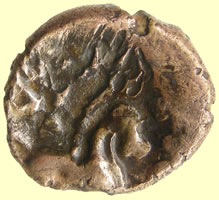 |
17.43mm,5.51g |
Qtr stater 5.26g,18.65mm |
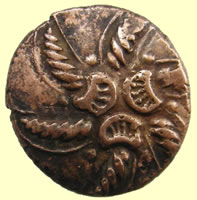 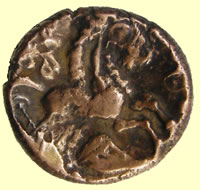 |
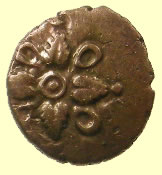 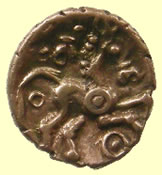 |
5.54g,17.39mm |
1.26g, 11.98mm |
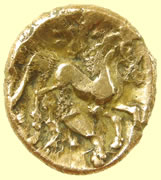 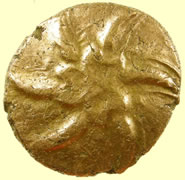 |
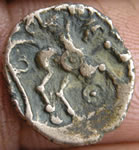 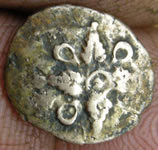 |
18.64mm, 5.61g Very unusual die strike - gold appears to be in an almost non moldern state during the strike |
Qtr stater 1.26g, 13.19mm |
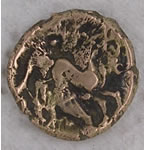 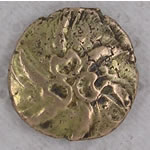 |
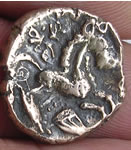 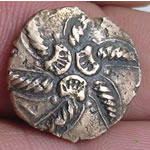 |
| 17.75mm, 5.64g CCI 06.0445 | 18.62 mm - 5.48 g 'that's a fine coin to start the season with! It'll be CCI 06.0412.' |
 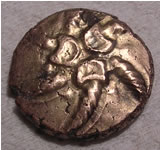 |
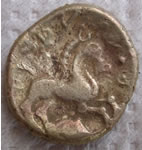  |
| 5.58g, 15.72mm CCI 05.0752 |
5.45g, 18.78 mm 'thanks very much for these, nice to see another Addedomaros after a gap of a few weeks! This one will be CCI 05.0749. The obverse is good, looks like one of the earlier dies in the series with the pellets between the arms. It's interesting that this one is that much further from the bulk of the other coins; it still fascinates and puzzles me, trying to work out exactly what sort of site you've got there, or what the precise pattern is behind the deposition of the coins'. |
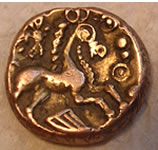 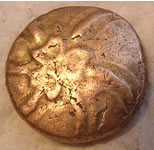 |
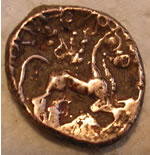 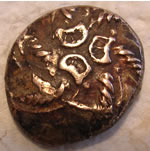 |
5.50g, 16.35mm CCI 05.0679 |
5.63g, 17.96mm CCI 05.0678 |
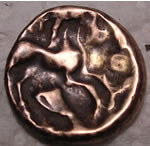 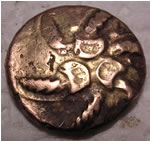 |
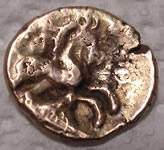 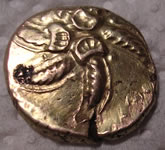 |
| 5.55g, 16.02mm | 5.51g - 19.05 m This one will be CCI 05.0667. As you say, a very well-used reverse die. I think I recognize the die - after looking at these quite intensively over the last year or two, the individual dies start to become recognizable. The obverse is on the other hand pretty sharp, and must have been struck from a fairly fresh die. |
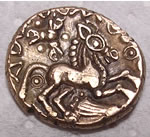 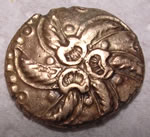 |
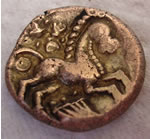 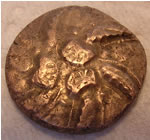 |
'this one's a real cracker! Certainly one of the best I've recorded in recent years, with just a little wear, as you say. The quality of the engraving is also extremely high - I'm sure these must have been among the first dies engraved for this type. The horse's muzzles which I mentioned last time are particularly neat here, it's really unusual to see them quite so clearly. I also suspect, though I haven't worked out how to prove it yet, that the coins with the pellets between the spiral arms are the earlier examples of this type. I'll record this one as CCI 05.0655' |
'Well, this is a nice one, and as you say with those intriguing symbols above the horse visible. What they seem to be is three horse's muzzles - on some dies they are virtually identical to the muzzle actually on the horse. Curiously, at roughly the same time that Addedomaros was using this motif on his staters, so was Commios, down in Hampshire. In fact since Commios is generally dated a little earlier than Addedomaros, it's not impossible that the latter encountered one of Commios's staters and decided to copy this feature. It quite often appears blundered, which suggests that the die engravers didn't always know what they were looking at. I'll record this one as CCI 05.0603, and I look forward to more! |
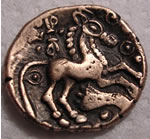 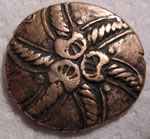 |
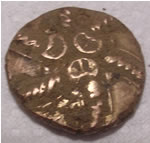 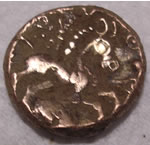 |
5.53g 18mm CCI 05.0290 |
5.62g 17mm CCI 05.0291 |
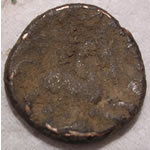 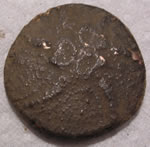 |
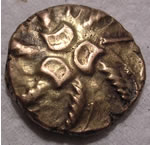 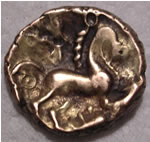 |
5.63g,17mm CCI 05.0293 |
5.57g 16mm CCI 05.0292 |
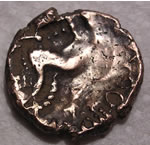 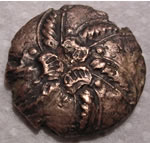 |
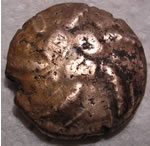 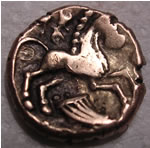 |
| 19 mm, 5.45g CCI 05.0285 | 17mm 5.42g |
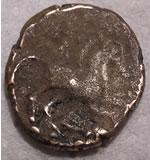 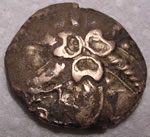 |
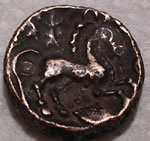 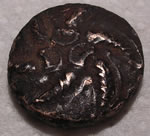 |
| 45- 30 BC 18 mm 5.62 g CCI 05.0286 | 5.30g 16mm CCI 05.0267 |
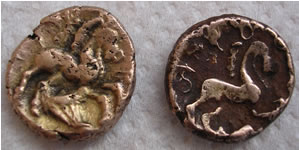 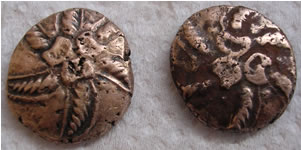 |
|
| Left example 5.64g, 16mm
CCI 05.0212 Right example 5.54g, 17mm CCI 05.0213 |
|
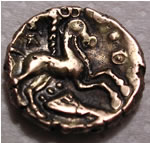 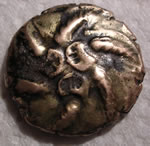 |
  |
5.56g 17mm CCI 05.0211 |
5.50g 17mm Thanks to Philip at the CCI for this update 'a very nice example of the Addedomaros spiral stater, VA 1620. Lots of them about now (150 plus) but this is a very decent example - though as usual without a trace of the reverse inscription, all off the edge of the flan. VA's dating is a bit unrealistic, I would suggest anywhere between 45 and 30 BC, but certainly a little later than the Gallo-Belgic stater you recorded before. This one will be CCI 05.0196. |
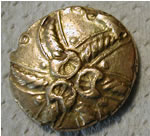 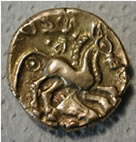 |
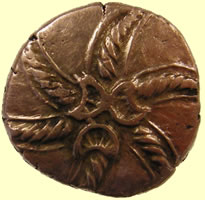 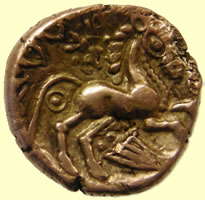 |
CCI No 04.0678 'this is a very good example, both sides nice and sharp. I'm doing some detailed work on the dies of this type at the moment, there are quite a lot - something like 25-30 obverse dies and maybe 50 for the reverse - so it must have been quite a sizeable coinage, probably produced over a number of years. Somewhere between about 45 - 25 BC is probably a reasonable guess'. |
Addedomaros 45BC Celtic gold stater - sent to CCI for recording 18.32mm, 5.48g The nice new Addedomaros is 13.0618, good to see a bit of the legend on the reverse. All the best John |
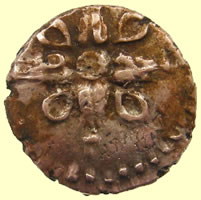 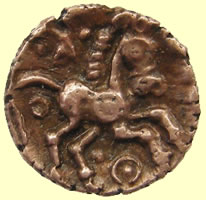 |
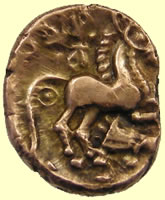 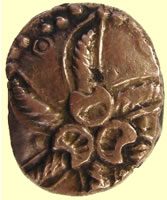 |
Addedomarus 45BC Celtic gold qtr stater - sent to CCI for recording 13.22mm, 1.33g It's always good to see another one of these, the obverses of this particular type of Addedo quarter are a nightmare to die link because they're so similar so the more examples there are the better; I've recorded it as 13.0558. Best Wishes John |
Addedomarus 45BC Celtic gold full stater - sent to CCI for recording 18.42mm, 5.53g 13.0533 |
  |
  |
Addedomarus 45BC Celtic gold full stater - sent to CCI for recording 17.13mm, 5.54g 13.0532 |
Addedomarus 45BC Celtic gold full stater - sent to CCI for recording 17.70mm, 5.56g I've recorded the latest Addedo stater as 13.0498, another fine looking coin. If it's OK with you I'll wait till later in the season to send information about the die links, as I mentioned the Index is in storage till mid October and it's almost as quick to die link several coins as it is to do one or two. John |
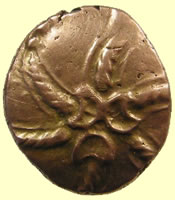 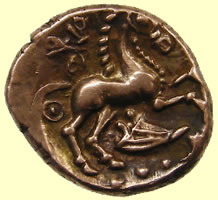 |
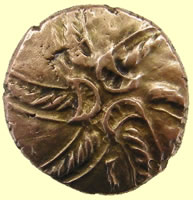 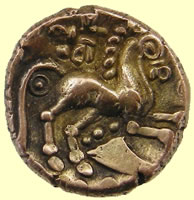 |
Addedomarus 45BC Celtic gold full stater - sent to CCI for recording & reported as potential addition hoard to museum 18.68mm, 5.61g 13.0488 |
Addedomarus 45BC Celtic gold full stater - sent to CCI for recording & reported as potential addition hoard to museum 17.98mm, 5.57g 13.0487 |
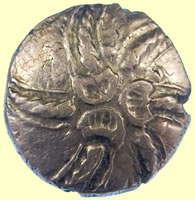 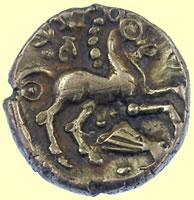 |
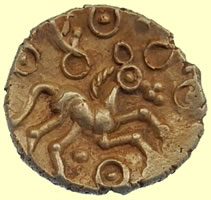 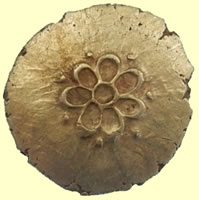 |
45 BC to 25BC Addedomarus - Trinovantian tribe Celtic gold stater - sent to PAS for recording 5.58g, 18mm |
Stunning strike of 45 BC to 25BC Addedomarus - Trinovantian tribe Celtic gold qtr stater - flower type - sent to PAS for recording VA1608 Very rare 13mm,1.36g |
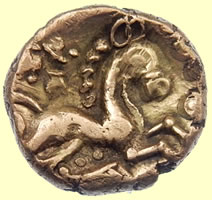 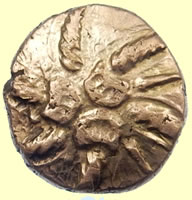 |
  |
45 BC Addedomarus Celtic gold stater - reported to PAS for recording 16.5mm, 5.48g |
45 BC Addedomarus Celtic gold qtr stater - reported to PAS for recording 13.1mm, 1.33g |
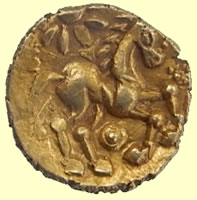 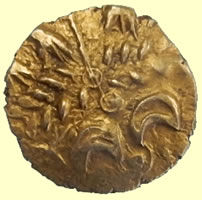 |
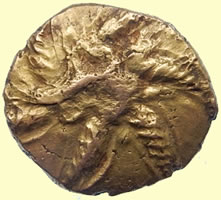 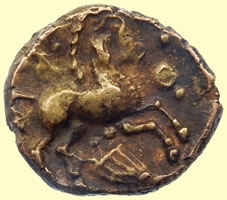 |
Probably a 40 BC Southern style QC type or even a Regini - it is inbetween the two, classed as rare Sent to PAS for recording 12.1mm,1.36g |
45 BC Addedomarus Celtic gold stater - reported as hoard to museum 5.57g, 18.2mm |
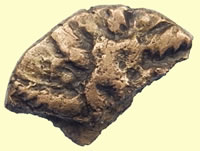 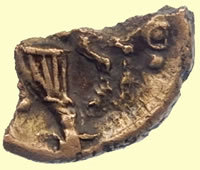 |
 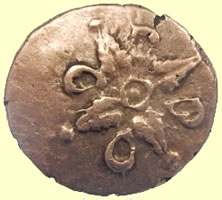 |
Addedomarus 45BC Celtic gold full stater fragement - sent to museum as hoard addendum 16.5mm,2.31g |
Addedomarus 45BC Celtic gold qtr stater - sent to PAS for recording 1.30g,13.07mm |
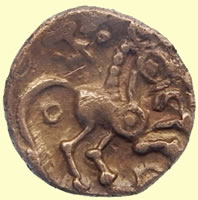 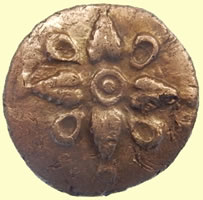 |
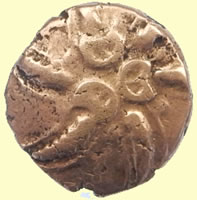 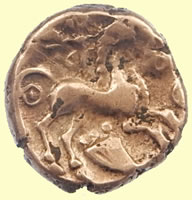 |
45 BC to 25BC Addedomarus - Trinovantian tribe Celtic gold qtr stater - sent to PAS for recording 1.34g, 12.34mm |
45 BC Addedomarus (sometimes written Aθθedomarus on coins) Celtic gold full stater Reported as hoard to museum 5.48g, 16.54mm |
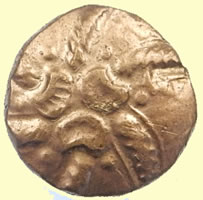 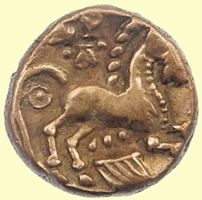 |
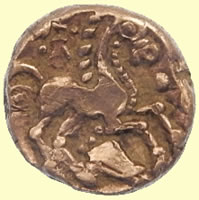 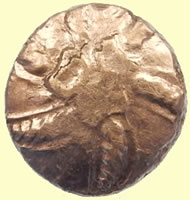 |
45 BC Addedomarus (sometimes written Aθθedomarus on coins) Celtic gold full stater Reported as hoard to museum 5.42g, 15.79mm |
45 BC Addedomarus (sometimes written Aθθedomarus on coins) Celtic gold full stater Reported as hoard to museum 5.58g, 16.43mm |
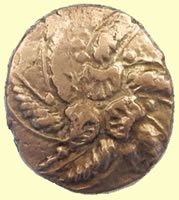 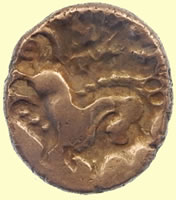 |
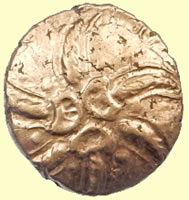 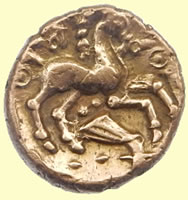 |
45 BC Addedomarus (sometimes written Aθθedomarus on coins) Celtic gold full stater Reported as hoard to museum 5.58g, 18.27mm |
45 BC Addedomarus (sometimes written Aθθedomarus on coins) Celtic gold full stater Reported as hoard to museum 5.49g, 18.40mm |
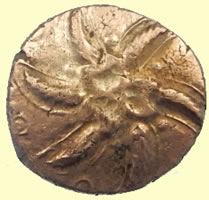 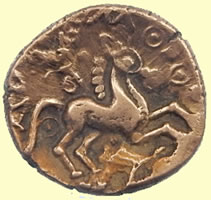 |
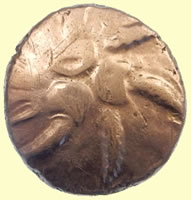 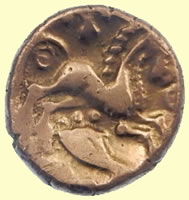 |
45 BC Addedomarus (sometimes written Aθθedomarus on coins) Celtic gold full stater Reported as hoard to museum 18.54mm,5.49g |
45 BC Addedomarus (sometimes written Aθθedomarus on coins) Celtic gold full stater Reported as hoard to museum 17.35mm,5.49g |
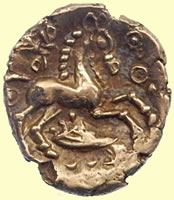 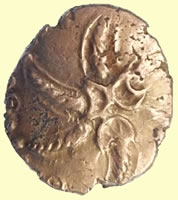 |
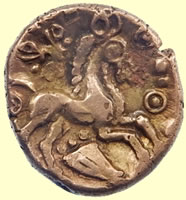 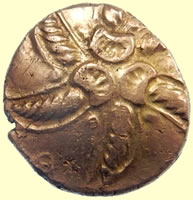 |
45 BC Addedomarus (sometimes written Aθθedomarus on coins) Celtic gold full stater Reported as hoard to museum 5.54g,20.37mm |
Addedomaros 45BC Celtic gold stater - reported to museum as hoard addendum 5.48g, 17.73mm |
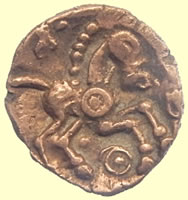 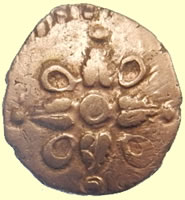 |
  |
Addedomarus 45BC Celtic gold qtr stater - sent to PAS for recording 13.35mm,1.29g |
45 BC to 25BC Addedomarus - Trinovantian tribe Celtic gold qtr stater - sent to PAS for recording 1.32g,13.23mm |
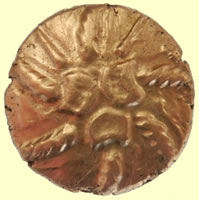 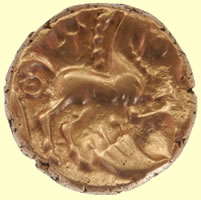 |
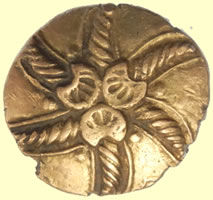 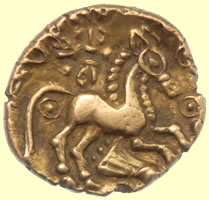 |
45 BC to 25BC Addedomarus - Trinovantian tribe- reported as hoard addendum to museum 5.45g,16.55mm |
45 BC to 25BC Addedomarus - Trinovantian tribe- reported as hoard addendum to museum 5.59g,18.55mm |
  |
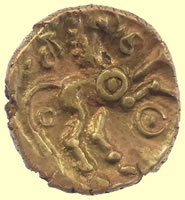 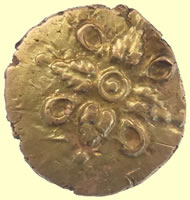 |
45 BC to 25BC Addedomarus - Trinovantian tribe Celtic gold qtr stater - 1.30g,13.12mm |
45 BC - 25 BC Addedomarus Celtic gold qtr stater - Floral type - sent to PAS for recording 1.29g,12.46mm |
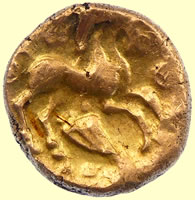 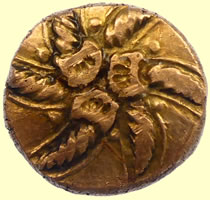 |
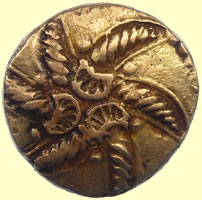 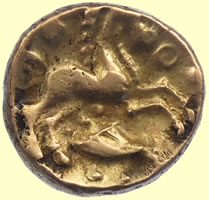 |
45 BC to 25BC Addedomarus - Trinovantian tribe- reported as hoard addendum to museum 5.58g.16.90mm |
45 BC to 25BC Addedomarus - Trinovantian tribe- reported as hoard addendum to museum 5.44g, 17mm |
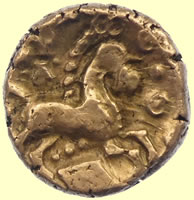 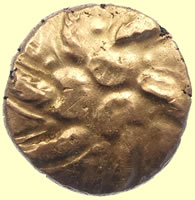 |
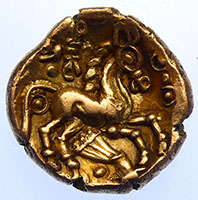  |
45 BC to 25BC Addedomarus - Trinovantian tribe- reported as hoard addendum to museum 5.54g,17mm |
45 BC to 25BC Addedomarus Celtic gold stater - Trinovantian tribe 5.52g, 18.37mm |
|
|
45 BC to 25BC Addedomarus Celtic gold stater - Trinovantian tribe 5.55g, 17mm dia |
45 BC to 25BC Addedomarus Celtic gold stater - Trinovantian tribe -Sent to museum for recording 5.43g, 19mm dia |
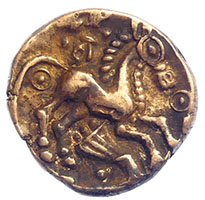 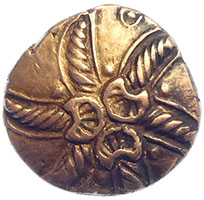 |
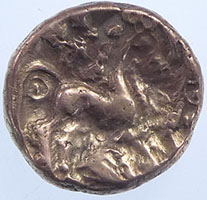 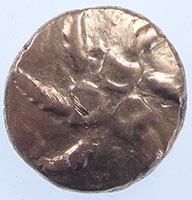 |
45BC Addedomaros Celtic gold stater - reported to museum 4.84G,17.38mm |
45BC Addedomaros Celtic gold stater - reported to museum 5.5g, 16.67mm |
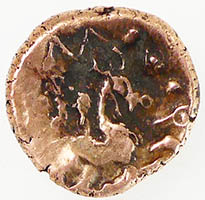 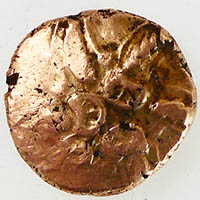 |
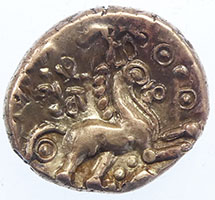  |
45BC Addedomaros Celtic gold stater 5.52g,16.65mm |
5.56g, 18.62mm 45 BC to 25BCAddedomarus - Trinovantian tribe |
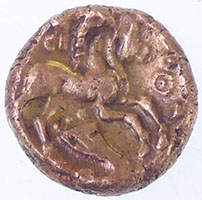 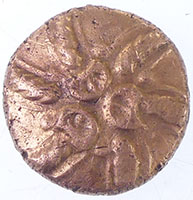 |
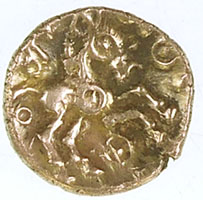 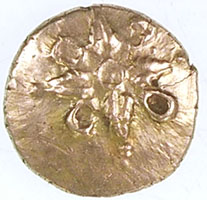 |
45BC Addedomaros Celtic gold stater 5.52g, 16.87mm |
45 BC to 25BC Addedomarus - Trinovantian tribe Celtic gold qtr stater - floral type 1.352g, 12.3mm dia |
  |
|
5 BC to 25BC Addedomarus - Trinovantian tribe 5.44g,16.96mm Reported as hoard addendum coin to museum |
|
AGRCATUVELLAUNI - AGR- HORSE GOLD QUARTER STATER 35-43 ADSuggested AGR is a Roman name like Agrippa or Agrippina.
Agr- AD 35-43 Celtic gold qtr stater. Corn ear without central stalk, CAM to L,CVN to R, , Horse rearing r, dashes to main, branch above, cross below, A in ex. 12.36mm, 1.245g
|
|
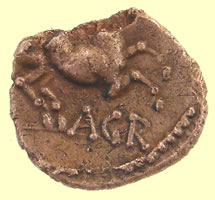 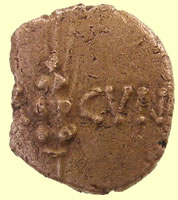 |
|
1/4 stater of Cunobelin Inscribed CAM CV AGR Ref Hobbs 1854 12.3mm.1.26g Cuno AGR quarter, BMC 1854, ABC 3002, not in VA. Extremely rare, good to see the full AGR and the bottom of the flan on the reverse despite the chip. CCI 12.0375
|
|
Cantii.
|
|
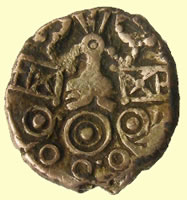 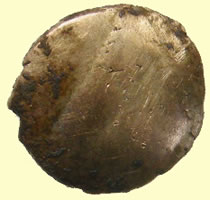 |
|
50 BC Uninscribed 'P' gold - 'Trophy' Type - 1/4 Celtic gold coin -1.33g, 10.43mm Beaded trophy quater, ABC 2243, BMC 435, not in VA. Extremely rare, 9 others known. An interesting Essex type because of its Kentish associations (derived from the Kentish trophy issue but a separate type), it may have been struck by an otherwise unknown offshoot of the Cantii. CCI 12.0370
This could be a 50BC Cantii Celtic gold qtr stater - sent to CCI for recording and confirmed ID 11.19mm, 1.40g Just found Jim's Celtic in my new Chris Rudd book and it is classed as Extremely rare - only 6 to 15 exist
50 BC Uninscribed 'P' gold - 'Trophy' Type - 1/4 Celtic gold coin - 1.38g, 11.99mm Beaded trophy quater, ABC 2243, BMC 435, not in VA. Extremely rare, 10 others known. An interesting Essex type because of its Kentish associations (derived from the Kentish trophy issue but a separate type), it may have been struck by an otherwise unknown offshoot of the Cantii.
50BC Cantii Celtic gold qtr stater It is a Floret Trophy type VA 146,BMC 436 attributed to the Cantii tribe - sent to PAS for recording 1.28g, 12.08mm
50 BC Uninscribed 'P' gold - 'Trophy' Type - 1/4 Celtic gold coin - 1.35g, 11.31mm - sent to CCI for recording Beaded trophy quater, ABC 2243, BMC 435, not in VA. Extremely rare, 10 others known. An interesting Essex type because of its Kentish associations (derived from the Kentish trophy issue but a separate type), it may have been struck by an otherwise unknown offshoot of the Cantii.
|
|
Catuvellauni
45- 40 BC Reported to museum 1.152g, 11.32mm
|
|
50 BC Clacton type Celtic gold - Trinovantian tribe |
|
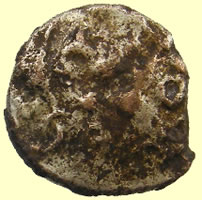 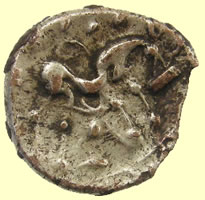 |
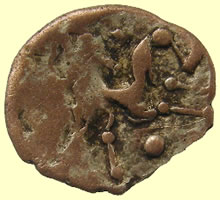 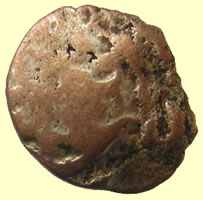 |
Qtr stater This example clearly shows the gold, copper, silver mix of these coins 13.62,1.33g I've recorded the latest Clacton quarter (1.33g) as 13.0083 John |
Trinovantes British G “Clacton” quarter, Hobbs 192 Celtic gold 1/4 stater 50BC Chris Rudd 23.41 Clacton de Jersey - Classed as scarce 1.28g,14.25mm |
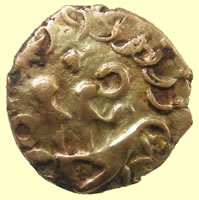 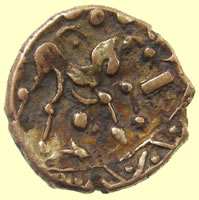 |
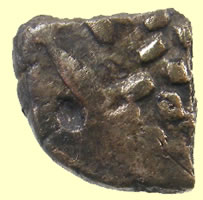 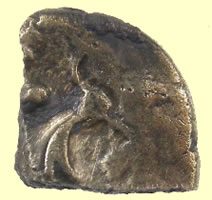 |
Trinovantes British G “Clacton” quarter, Hobbs 192 Celtic gold 1/4 stater 50BC Chris Rudd 23.41 Clacton de Jersey - Classed as scarce 1.41g, 11.93mm |
Late British G 'Early Clacton' CCI 12.0840 |
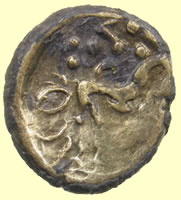 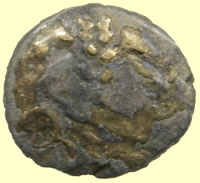 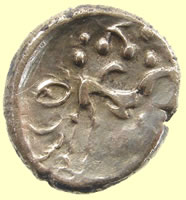 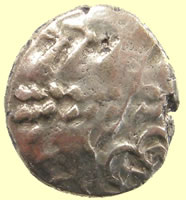 |
|
British G 'Early Clacton' gold stater 5.25g, 19.54mm CCI 12.0853 |
|
  |
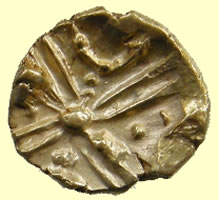 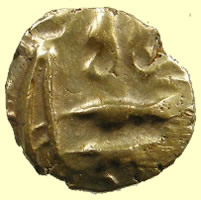 |
50 BC late British G 'Early Clacton' CCI 12.0843 5.07g, 19.7mm |
Celtic gold qtr stater - first off this type I have seen 12.0751) is a Clacton Cross type, ABC 2356, the companion quarter to British F, the Late Clacton stater, ABC 2332. In ABC it's illustrated as a 'three men in a boat' design but the obverse is probably a degraded boar and it should be the other way up; at the moment there are around 30 known, mostly from Essex and Suffolk so it's a definite Trinovantian type. John 1.42g, 13.55 mm |
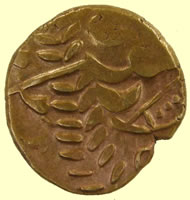 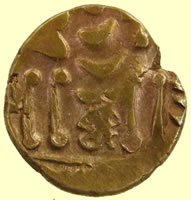 |
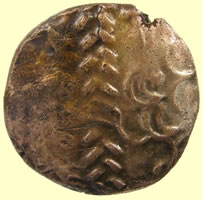 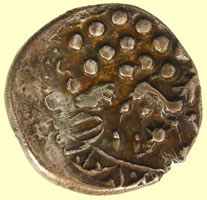 |
Celtic gold full stater - Clacton type 6.43g, 20.30mm Ref Hobbs 142 British A1 or E stater. This coin is from the same obverse die that was later used to strike the Waldingfield type, VA 1462, ABC 2335. It’s from an unrecorded reverse die with an uncertain symbol below the horse and is midway between the Westerham and Waldingfield types, if anything closer to the latter, which is extremely rare (not the Clacton type though this particular coin is very similar) CCI 12.0367 |
Excellent heavy full stater Disjointed horse, pellet below 19.76mm, 6.13g Late Clacton stater, VA 1455, ABC 2329. There are two main varieties of this type, one with a simple pellet below the horse and the other with a winged pellet or star; this is the latter type which is rarer than the simple pellet type, with only 10 others known. CCI 12.0377 |
|
|
1stC BC Celtic gold 1/4 stater Pictures as dug and after partial 'cooking' 14.46mm, 1.40g This one has been allocated the CCI number 10.1044. It is a British G “Clacton” quarter, Hobbs 192 (he mis-identified it as an H quarter for some reason). At least 44 known before this – from right across the area most people would label as territory of the Trinovantes... Ian |
|
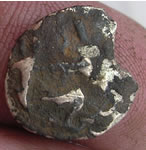 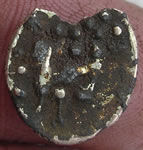 |
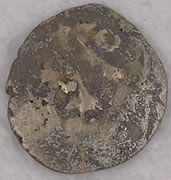 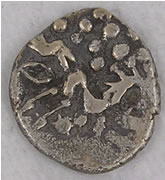 |
| Trinovantes Clacton type Celtic gold 1/4 stater 50BC 1.25g, 12.94mm - CCI 07.0124 | Trinovantes Clacton type Celtic gold 1/4 stater 50BC 1.28g, 13.72mm CCI 06.0491 |
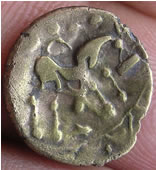 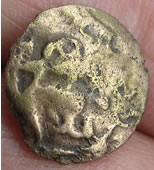 |
  |
Trinovantes Clacton type Celtic gold 1/4 stater 50BC 1.26g, 14.04mm CCI 06.0492 'many thanks for these two Clacton 50BC quarters. The first one will be CCI 06.0491, the second one 06.0492. Not much I can say about these except that the second one is probably the later of the two, struck from a rather more stylized reverse die. But 'later' in this context might only be a matter of days or weeks, I don't think these coins were struck over a very long period'. |
50BC Trinovantes Celtic gold (Clacton type)1/4 stater - 1.13g, 13.71g CCI 06.0188 The Clacton quarter is one of those where the wear on the obverse makes it look as though there's a face - and perhaps the Celts who saw the coin thought that too, although it is based on the same boat that appears on the Gallo-Belgic coin. Again it's not particularly rare, at least not anymore - there are a good dozen or more from this obverse die, and probably this reverse too although it's difficult to be sure from this image'. |
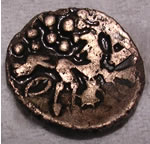 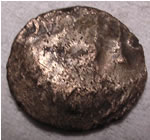 |
 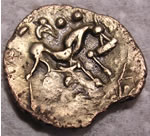 |
Trinovantes Celtic gold 1/4 stater 50BC- 1.29g 14mm 'yet another very interesting coin. This is a Clacton quarter stater, unlisted in Van Arsdell but in the British Museum catalogue (in the wrong place, with the Corieltauvi) as BMC 192, and in 'Coins of England' as no. 42. These coins were almost unknown in the late 1980s, but there are now about 60 of them recorded here, mostly from Essex and Suffolk. The reverse design is basically the same as the better-known Clacton stater (VA 1455), while the obverse has yet another interpretation of the three men in a boat design, here with two 'men', and sometimes looking like a human face. Unfortunately not readily visible on this one, though you should be able to pick out the outline of the boat. Of those 60 or so examples, possibly as few as two are struck from the same reverse die as this coin, which has several large flaws and is probably from late in the series (as the use of a nearly plain obverse die also suggests). Both of the earlier two coins came from Suffolk, one from Ipswich and the other near Alderton. The type probably dates to c. 50 BC and was definitely a production of the Trinovantes. CCI 05.296. |
'This is an example of the Clacton 1/4 stater - it's not listed in VA, but there's one in the British Museum catalogue, at BMC 192 (where it's incorrectly attributed to the Corieltauvi). These coins were virtually unknown until the 1980s, but we now have records of more than 50 of them, predominantly from Essex, and it seems certain to be the quarter stater type associated with the full Clacton stater. There is strong Gallo-Belgic influence, as you mention - the obverse seems to be copied from the 'three men in a boat' design found on the imported Gallo-Belgic quarter staters, while the reverse is indeed nearly identical to the Clacton stater type. Its date is probably c. 50 BC. This one will be in the Index as CCI 04.2136'. |
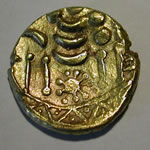 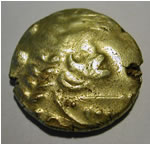 |
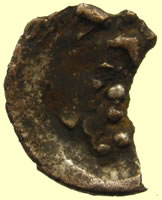 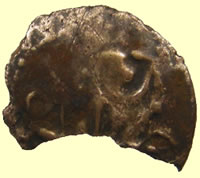 |
| 'It's a very nice example of one of the rarer Clacton types - only just over 20 of the basic type (VA 1458) are recorded, and there are some variations within that group (mostly in minor elements of decoration, and in particular the form of the 'flower' beneath the horse)'. It will be CCI 04.0481. '70 BC | Trinovantes Celtic gold 1/4 stater 50BC - sent to CCI for recording - reported as potential hoard 0.70g, 13.65mm 13.0670 - Clacton quarter, ABC 2350, looks like a late example with many pellets above the horse. |
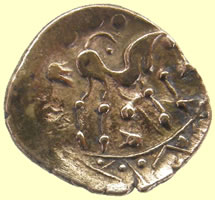 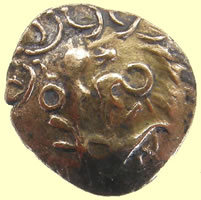 |
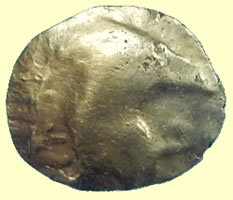 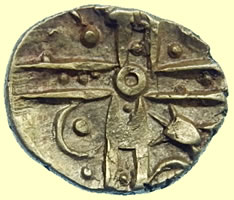 |
50 BC Trinovantes British G “Clacton” Celtic gold qtr stater - sent to CCI for recording and reported as hoard to museum 1.29g,14.45mm |
c 50 BC Celtic gold qtr stater - Similar to a Clacton Cross type but not a match in the Ref books, Hobbs and Rudd - sent to PAS for recording and ID 1.44g, 13.5mm Van Arsdell VA 1460-1 |
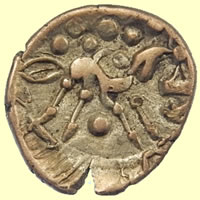 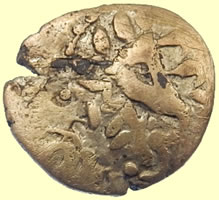 |
  |
Trinovantes British G “Clacton” quarter, Hobbs 192 Celtic gold 1/4 stater 50BC - sent to PAS for recording Chris Rudd 23.41 Clacton de Jersey - Classed as scarce 1.25g, 13.5mm |
50BC Clacton type Celtic gold qtr stater - sent to PAS for recording 13.1mm, 1.43g |
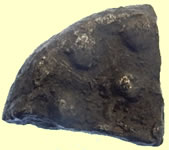 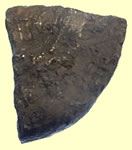 |
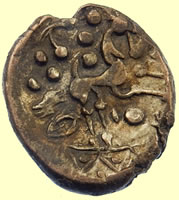 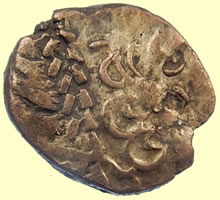 |
50 BC late British G 'Early Clacton' debased gold stater fragment - sent to PAS for recording 0.55g, 9.9mm |
50 BC late British G 'Early Clacton' gold stater - sent to PAS for recording 20mm, 5.73g |
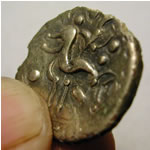 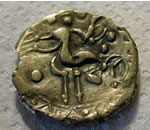 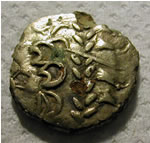 |
|
| Hard to imagine the skill required in those days to to put two thin gold sheets over a bronze inner. Contemporary forgery of 'Clacton' type gold stater circa 70 BC | |
  |
  |
Trinovantes British G “Clacton” quarter, Hobbs 192 Celtic gold 1/4 stater 50BC Chris Rudd 23.41 Clacton de Jersey - Classed as scarce 1.47g,14.2mm Reported as hoard addendum to museum |
Trinovantes British G “Clacton” quarter, Hobbs 192 Celtic gold 1/4 stater 50BC - sent to PAS for recording Chris Rudd 23.41 Clacton de Jersey - Classed as scarce 1.41g, 11.93mm |
  |
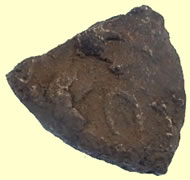  |
Trinovantes British G “Clacton” quarter, Hobbs 192 Celtic gold 1/4 stater 50BC Chris Rudd 23.41 Clacton de Jersey - Classed as scarce Reported to museum for recording 1.50g,13.39mm |
50 BC Trinovantes British British G 'Early Clacton' gold stater Debased gold 0.89g, 9.91mm Sent to museum for recording and addendum to existing hoard |
Celtic gold qtr stater 50 BC Clacton Dragon type Rev Traces of 'three men in a boat'design Obv Central bar with appendages foring 'dragonesque' motif
1.38g, 13.42mm Great find, it's a new reverse variant of the British F 'Dragon' type, ABC 2353 for an earlier version with open-mouthed beast clearly visible and DK 422 for a later, jumbled variant; all the known examples are from the same obverse die, here seen quite worn. As with the Maldon quarter I'll send a CCI number as soon as I've finished the Iceni silvers. All the best John |
|
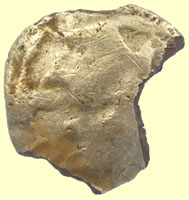 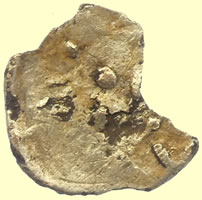 |
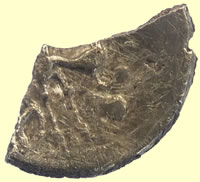 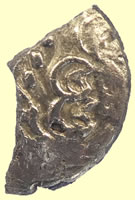 |
Trinovantes Clacton type Celtic gold 1/4 stater 50BC - reported as haord addendum 0.83g,12.35mm |
50 BC late British G 'Early Clacton' gold stater - reported to museum as hoard addendum |
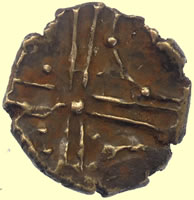 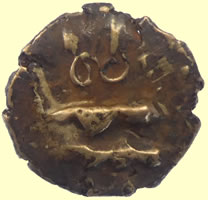 |
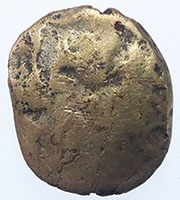 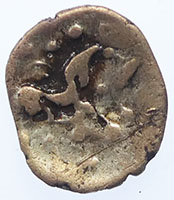 |
25 BC Clacton Cross type, ABC 2356, the companion quarter to British F, the Late Clacton stater, ABC 2332. In ABC it's illustrated as a 'three men in a boat' design but the obverse is probably a degraded boar ; at the moment there are around 30 known, mostly from Essex and Suffolk so it's a definite Trinovantian type. Martin Reported to museum and CCI 1.41g,13.88mm |
Trinovantes British G “Clacton” quarter, Hobbs 192 Celtic gold 1/4 stater 50BC - reported to museum Chris Rudd 23.41 Clacton de Jersey - Classed as scarce 1.053g,13.75mm |
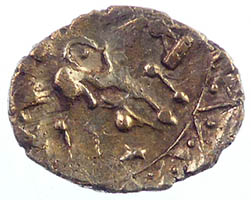 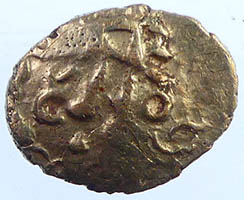 |
  |
Trinovantes British G “Clacton” quarter, Hobbs 192 Celtic gold 1/4 stater 50BC Chris Rudd 23.41 Clacton de Jersey - Classed as scarce 1.34g,15.1mm |
25 BC Clacton Cross type, ABC 2356, the companion quarter to British F, the Late Clacton stater, ABC 2332. In ABC it's illustrated as a 'three men in a boat' design but the obverse is probably a degraded boar ; at the moment there are around 30 known, mostly from Essex and Suffolk so it's a definite Trinovantian type. 1.37g, 12.7mm |
Corieltauvi - 1stC BC
|
|
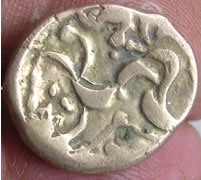  |
|
1stC BC Corieltauvi celtic stater CCI 07.0103
'many thanks for the images, this is very interesting. It's your first Corieltauvi - to be precise the kite stater, listed as VA 825, nos 3181-3184 in the BM catalogue and no. 392 in 'Coins of England'. The reverse needs to be rotated 180 degrees and you get the horse left, with the diamond-shaped kite above containing pellets; and faint remains of a wreath design on the obverse. This type has become relatively common in the last few years because of some substantial hoard finds in East Yorkshire - something like 150 recorded now. It's fairly unusual to see one down in Essex, although there are a few Corieltauvian coins from the county. In terms of date it's probably very late first century BC; most of these coins are either in base gold or plated. All in all a very interesting addition to your finds. I'll record this as CCI 07.0103'. Dr Philip de Jersey
Uninscribed Corieltauvi North Eastern gold - 'Ferriby' type gold stater - Contemporary forgery 'excessively rare Celtic gold coin' Ref Hobbs 3167 |
|
9AD to 40 AD Cunobelin - Catuvellauni
Cunobeline (or Cunobelin, from Latin Cunobelinus, derived from Greek Kynobellinus, Κυνοβελλίνος) was a king in pre-Roman Britain from the late first century BC until the 40s AD. He is mentioned in passing by the classical historians Suetonius and Dio Cassius, and many coins bearing his inscription have been found. |
|
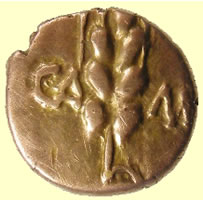 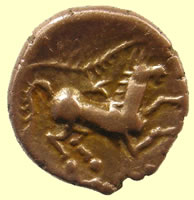 |
|
1/4 stater of Cunobelin Cunobelin wild type quarter, CCI 12.0752 1.34g,10.8mm |
|
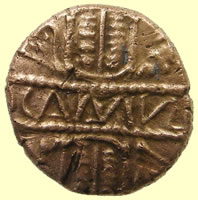 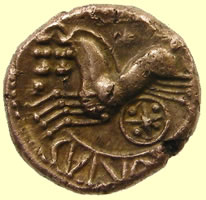 |
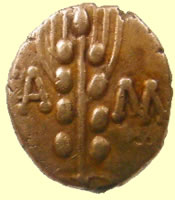 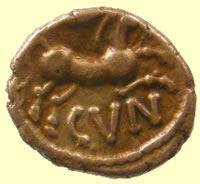 |
Celtic gold full stater - very rare bigga type
5.51g, 16.86 Cunobelin biga stater, VA 1910, BMC 1769-1771, ABC 2771. Still very rare. CCI 12.0372 |
Celtic gold qtr stater - 11.55mm, 1.33g Cunobelin linear type quarter, VA 1927, ABC 2810 CCI 12.0373 |
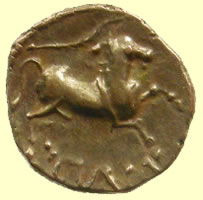 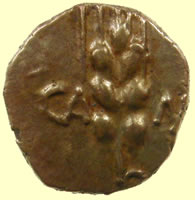 |
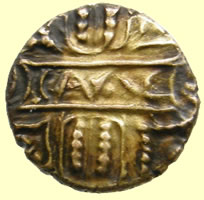 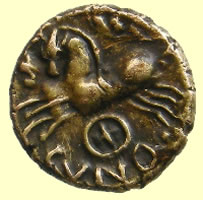 |
Celtic gold qtr stater - 11.89mm,1.22g Cunobelin wild type quarter, VA 1935, ABC 2813 CCI 12.0374 |
Celtic gold qtr stater biga type 10 to 40 AD 1.36g, 10.93mm Cunobelin biga stater, VA 1910, BMC 1769-1771, ABC 2771. Still very rare. CCI 12.0372 |
  |
  |
Cunobelin Celtic gold qtr stater - sent to CCI for recording 12.41mm, 1.26g Thanks for the Cunobelin quarter from *****, CCI 09.3504.
It can be tricky to tell the various types apart because with some of them there's no clear dividing line and the Wild and Plastic types in particular are very similar, but this looks like the Plastic type, Van Arsdell 2015-1.
All the best
John |
Very interesting die type of a 10 to 40 AD Cunobelin 1/4 gold stater - note the blocked horse. Sent to Celtic Coin index for recording and more information on type 0.83g, 11.84mm |
  |
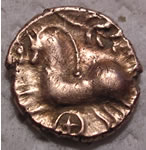 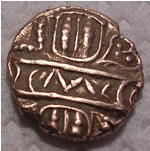 |
Cunobelin Celtic gold stater 5.44g, 17.89mm - Northern Gold 'Linear type' Obv corn ear,to 1 CA, to r.MV, below CA cross Rev horse r ., pellet, leaf q & pellet, below CVN, pellet boarder va 1925 Ref Hobbs 'Thanks for this, a fine Cunobelin linear stater indeed. There are a few with the pellet over the M within the group listed as VA 1925.05 in the online CCI, at Among these coins such as |
Celtic gold 1/4 stater (Biga type) head facing left 1.38g, 10.89 mm
'another cracking little coin. It is the biga type as you say, still quite rare: we have just over 20 of the quarter recorded. I had hoped to have a look at the dies in comparison to the rest of the coins in Oxford this morning, but ran out of time and I'm now back in Guernsey again. That'll have to wait a while, but in the meantime it looks as though it's one of the later strikings of this type, because of the simplified CAMVL inscription on the obverse. The earliest examples have each letter very clearly defined, but they soon merge into what looks almost like a zigzag on some coins. Saying it's a 'late striking' is all relative of course: it's possible that the biga type was struck over a very short period, perhaps even just months and certainly unlikely to be more than say five years or so, sometime around 8 - 13 AD I would estimate. It'll be CCI 05.0688 |
1stC AD Cunobelin Celtic gold 1/4 stater 1.32g, 13.43mm - Cunobelin full Celtic Stater 5.38g, 19.24mm CCI 07.0181, the 'A' quarter stater: 12 of these. This is one of the best for the reverse, it's unusual to get just about the whole 'A' visible.
CCI 07.0182, the wild stater (VA 1933): not so scarce, almost 90 recorded, but a fine coin nonetheless. Interestingly it's from the same pair of dies as one of your earlier Cuno staters, CCI 04.0679.
|
|
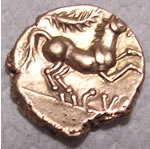 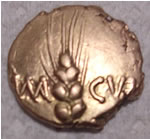 |
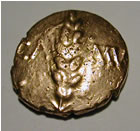 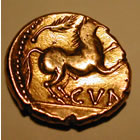 |
1/4 Gold stater
The Cunobelin quarter is rarer. It's actually the so-called 'plastic' type, VA 2017 (CCI 04.2296). The key to its identification is that it's the only Cunobelin type which has CAM CVN on the obverse, rather than the usual CAMV. We have records of just 17 other examples. There are also other, rarer subtypes, which have A or AGR on the reverse coupled with this obverse'. |
Gold full stater 10 to 40 AD Celtic coin Index as CCI 03.0811. |
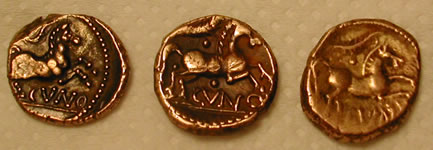  |
|
| 3 - 40AD
Cunoblein staters found as a hoard
CCI 04.0477 'classic A' series, VA 2027-1. Generally believed to have been the last major series of his gold, so probably dating from the 30s AD. There are three or four matches for this particular pair of dies in the CCI, among the c. 100 of the basic type. The decoration at the base of the corn-ear is a bit more showy than usual. CCI 04.0478 'plastic A' series, VA 2010-3. Believed to have preceded the classic type, so perhaps from c. 25 - 35 AD. About ninety of these are recorded here, and again there are a number of matches for both of these dies, including at least one coin in the British Museum (BMC 1819 in Hobbs's Catalogue of Iron Age coins in the BM). CCI 04.0479 'linear' series, VA 1925-1. The earliest of these three, perhaps from c. 20 AD, and a little rarer, with about 60 recorded here. Again there is a coin in the BM from the same pair of dies, BMC 1783. There are a couple of rather unusual features to the dies - although not clear on your example because of the position it has been struck, there appears to be no V on the end of CAMV, and there's also a mark - perhaps some kind of privy mark - after the CVN on the reverse, you can just see the top of what looks like a letter I between the N and the horse'sfront legs on your coin. On display in Colchester museum |
|
  |
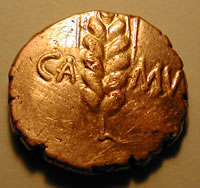 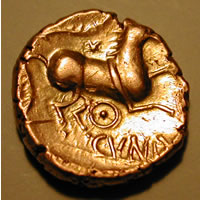 |
| Cunobelin (Colchester Celtic King) gold Qtr stater 10 to 40 AD 1.23g 10mm | 'CCI No 04.0679 is the Cunobelin wild type stater, VA 1933-1. Again a nice example, 75 of the basic VA 1933 type recorded although there are some minor variations in the size of the star over the horse (Van Arsdell splits them into small and large, but it's not always easy to decide where small ends and large begins!). Probably somewhere around the middle of his reign, perhaps c. 20 - 25 AD'. |
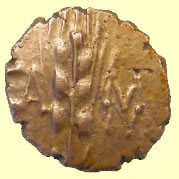 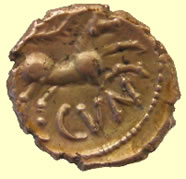 |
  |
10-40 AD Cunobelin gold qtr stater - sent to CCI for recording 1.33g, 12.82mm 13.0486 |
10-40 AD Cunobelin qtr gold stater - sent to CCI for recording 1.31g, 11.16mm |
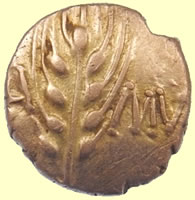 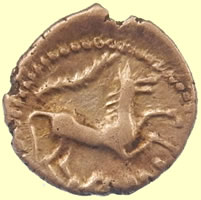 |
  |
10 - 40 AD Cunobelin gold qtr stater - sent to PAS for recording 1.32g, 12mm |
0-40 AD Cunoblein Celtic gold qtr stater - sent to PAS for recording 1.34g, 10.1mm |
  |
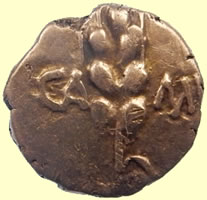 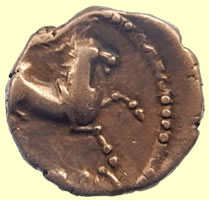 |
10-40 AD Cunobelin full gold stater - sent to PAS for recording 5.43g,19.8mm |
10- 40 AD Cunobelin Celtic gold qtr stater - sent to PAS for recording 1.31g, 11.16 mm |
  |
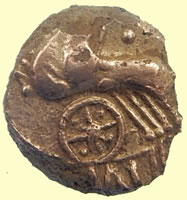 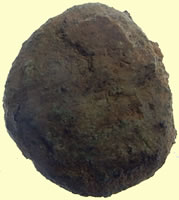 |
10- 40 AD Cunobelin Celtic gold qtr stater - sent to PAS for recording 1.33g, 11.57mm |
10-40 AD Cunobelin biga qtr stater, VA 1910, BMC 1769-1771, ABC 2771 Very rare. 11.48mm, 1.26g |
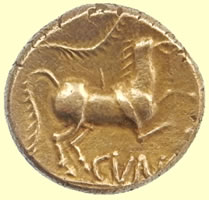 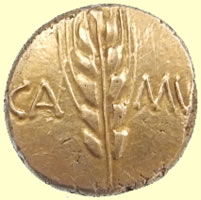 |
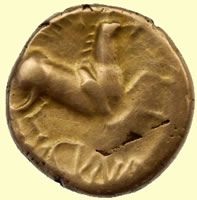 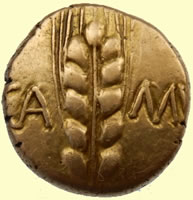 |
Celtic gold Cunobelin stater - 'linear' series, VA 1925-1. The earliest of the rule, perhaps from c. 20 AD, and a little rarer, with about 60 recorded here 15.95, 5.48g Sent to museum for recording |
10-40 AD Cunobelin Cetic gold stater - 'linear' series, VA 1925-1. The earliest of the rule, perhaps from c. 20 AD 5.45g,16mm Sent to museum for recording |
  |
  |
c20 AD Cunobelin gold qtr stater - linear series - sent to PAS for recording 11.37mm,1.36g |
10-40 AD Cunobelin Cetic gold stater - 'linear' series, VA 1925-1. The earliest of the rule, perhaps from c. 20 AD 5.45g,16mm |
  |
 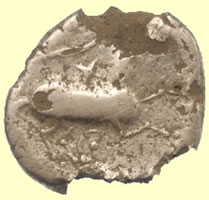 |
10-40 AD Cunobelin Celtic gold qtr stater - sent to museum for recording 1.32g,11mm |
Cunobelin wild type gold contemporary forgery stater, VA 1933-1. VA 1933 type recorded although there are some minor variations in the size of the star over the horse (Van Arsdell splits them into small and large, but it's not always easy to decide where small ends and large begins!). Probably somewhere around the middle of his reign, perhaps c. 20 - 25 AD'. |
  |
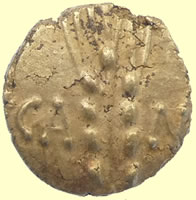 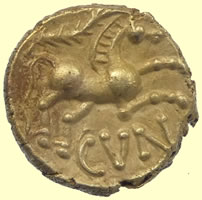 |
10-40 AD Cunobelin Celtic gold stater - Linear type -sent to PAS for recording VA1925 BMC 1772-83 16mm,5.37g |
10-40 AD Cunobelin Celtic gold Linear type qtr stater - reported to PAS Ladder main - branch above 11.36mm,1.28g Ref ABC 2810 - Rare |
  |
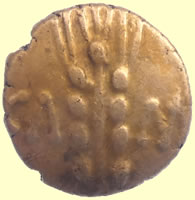 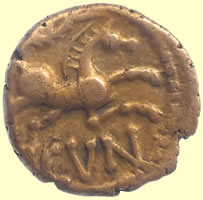 |
c25-35 AD Cunobelin Celtic gold full stater - reported to PAS 'plastic A' series, VA 2010-3. Believed to have preceded the classic type, so perhaps from c. 25 - 35 AD. About ninety of these are recorded including at least one coin in the British Museum (BMC 1819 in Hobbs's Catalogue of Iron Age coins in the BM). 5.45g, 16.88mm Rudd 92-45 ABC 2789 Excessively rare |
10-40 AD Cunobelin Celtic gold Linear type qtr stater - reported to PAS Ladder main - branch above 11.19mm,1.34g Ref ABC 2810 - Rare |
10-40 AD Cunobelin Celtic gold Classic Bow type qtr stater - reported to PAS 1.32g,11.38mm Ref Rudd 75 57 - Excessively rare ABC 2825 |
|
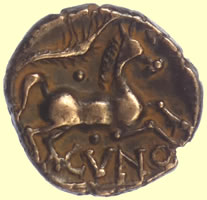 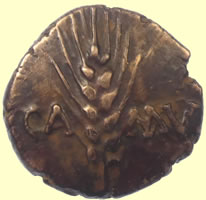 |
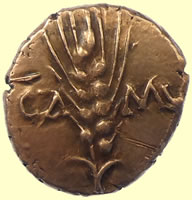 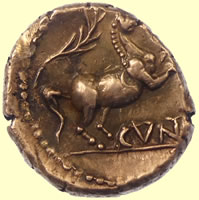 |
10-40 AB Cunobelin Celtic gold stater - sent to museum and CCI for recording 17.33,5.41g |
10-40 AB Cunobelin Celtic gold stater - sent to museum and CCI for recording 18.25g,5.42g |
  |
  |
10-40 AB Cunobelin Celtic gold stater - sent to museum and CCI for recording 17mm,5.38g |
c25-35 AD Cunobelin Celtic gold qtr stater - reported to museum and CCI for recording plastic A' series, VA 2010-3. Believed to have preceded the classic type, so perhaps from c. 25 - 35 AD. 1.33g,10.50mm It's an early Classic quarter, class 7a, DK 588, with a Classic type design but dies cut by an engraver who had previously worked on the Plastic series, which is why it has the 'look' of a Plastic type.
If you could let me know which parish it was found in I'll add it to the card,
All the best John
|
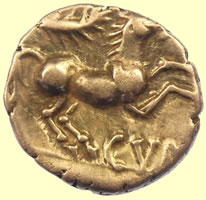 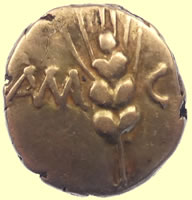 |
  |
10- 40 AD Cunobelin Celtic gold qtr stater -reported as hoard addendum coin to museum 1.35g,11mm |
Celtic gold qtr stater - 9.45 mm,1.26g - Sent to museum for recording Cunobelin wild type quarter, VA 1935, ABC 2813 |
  |
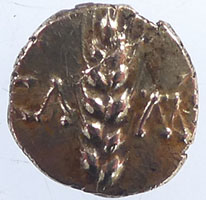 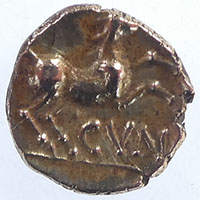 |
Celtic gold qtr stater - 11.11 mm,1.32g - Sent to museum for recording looks like a Northern Gold 'Linear type' - pellet over M Obv corn ear,to 1 CA, to r.MV Rev horse r ., pellet, leaf q & pellet, below CVN, pellet boarder va |
10-40 AD Cunobelin Celtic gold qtr stater - reported to museum Wild type - Corn ear without cental stork CA to l, MV to r. Horse r, dashes for mane, branch above, CVN below VA2015 Classed as Scarce 1.366g, 10.89mm |
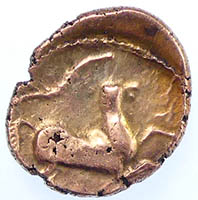  |
  |
10-40 AD Cunobelin Celtic gold stater 5.36g, 19mm |
10-40 AD Cunobelin Celtic gold qtr stater 1.3g,11.12mm |
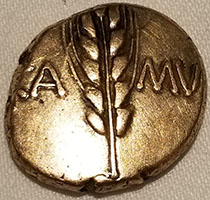  |
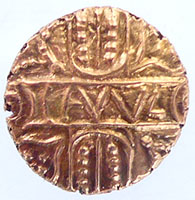 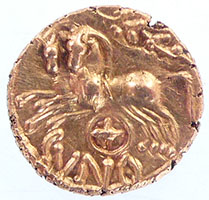 |
10-40 AD Cunobelin Celtic gold stater 5.5g, 17.97mm |
1.35g, 11.49mm 8-13 AD Celtic gold Cunobelin qtr stater- Bigga type |
  |
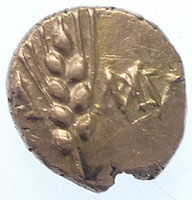 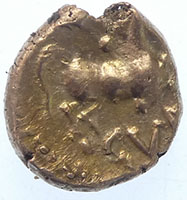 |
10-40 AD Cunobelin Celtic gold qtr stater 1.424g, 11.04mm |
10-40 AD Cunobelin Celtic gold qtr stater - reported to museum 1.33g, 10.76mm |
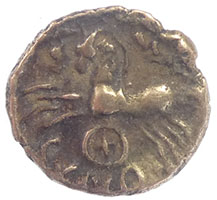  |
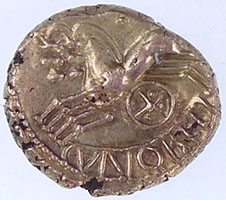 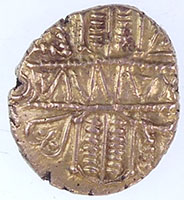 |
8-13 AD Cunobelin biga type qtr gold stater 1.32g, 12.01mm |
10-40 AD Cunobelin Celtic gold stater - biga type - reported to museum
camvl in garnished tablet on vertical wreath, heart-shaped symbols in quarters, rev. biga left, leaf above, wheel and [cvnobelin] below (ABC 2771; 5.44g, 19.03mm |
10-40 AD Cunobelin Celtic gold qtr stater - Plastic type - reported to museum 1.22g, 11.04mm |
|
Dubnovellaunos 25 BC to 5 AD
A king called Dubnovellaunus succeeded his father Addedomarus as king of the Trinovantes ca. 10-5 BC and ruled for several years before being supplanted by Cunobelinus of the Catuvellauni. |
|
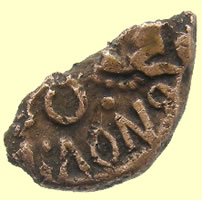 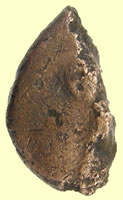 |
  |
Broken Celtic gold full stater - Dubnovellaunos 5 BC to 10 AD 1.68g, 13.74mm The broken stater can be 13.0083. By coincidence I was looking at these yesterday, it's a Dubnovellaunos in Essex stater, ABC 2392, BMC 2425-2440, Van Arsdell 1650; there should be just enough of the legend showing to be able to die link the reverse. It's not a particularly rare type, over 100 in the Index at present. Hope the rest turns up, it's not unknown for different fragments of the same coin to turn up years apart! John |
Eastern uninscribed Celtic gold qtr stater of Dubnovellaunos 12.25mm,1.3g Dubnovellaunos in Essex quarter, VA 1660, BMC 2442, ABC 2395 CCI 12.0379 |
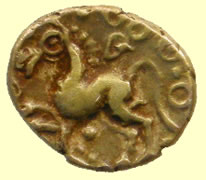 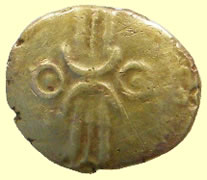 |
  |
Dubnovellaunus tribe Celtic gold qtr stater-11.73mm,1.32g Recorded as CCI 10.1046. Gold quarter stater of Dubnovellaunos, c. 20 BC-AD 10 Linear wreath, with opposed crescents; Horse left with branch below and trefoil design above VA 1660, BMC 2442 Around 25 provenanced examples of this type are known.... mainly from Essex or the Essex or Herts borders. Ian Ps. Note the figures for the British G quarter stater were also PROVENANCED examples only! CCI 10.1045 |
1stC BC Celtic gold qtr stater - Eastern gold attributed to Dvbnovellaunos tribe 1.34g,11.67mm Hobbs 2442 Page 146 Colchester find 'Eastern uninscribed gold quarter stater of Dubnovellaunos, c 20 BC-AD 10. Van Arsdell VA1660 =BMC 2442. CCI number: 10.0874' Ian |
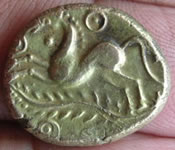  |
 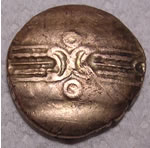 |
Dubnovellaunus c 20 BC-AD 10 Full Celtic gold stater 5.44g,17.57mm |
'many thanks for these, they're both very fine coins. The Dubnovellaunus stater is VA 1655-5, and will be CCI 04.2295. We have records of just under 100 of the basic Dubnovellaunus stater type (VA 1650-1655); it can be very difficult to split them further without studying the individual dies, because key motifs such as the inscription are often off the edge of the flan, as here. In fact this example is struck a long way off-centre on the reverse, since it's unusual to see just about the whole of the motif beneath the branch under the horse. |
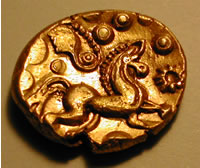 |
  |
| Dubnovellaunus 20 BC-AD 10 gold full stater | Eastern uninscribed Celtic gold full stater of Dubnovellaunus, c 20 BC Sent to CCI for recording 5.41g, 18.45mm |
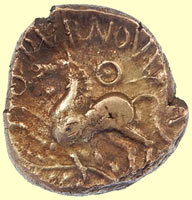 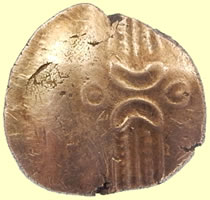 |
 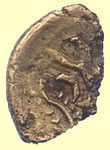 |
Stunning strike with full Kings inscription showing Eastern uninscribed Celtic gold full stater of Dubnovellaunus, c 20 BC- sent to PAS ID and recording 5.39g,19.1mm |
25BC Eastern uninscribed Celtic gold qtr stater of Dubnovellaunos 11mm,0.67g |
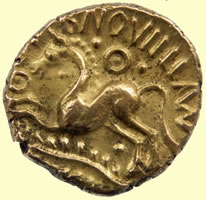  |
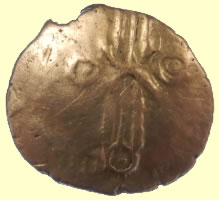 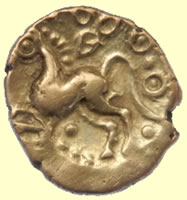 |
Eastern uninscribed Celtic gold full stater of Dubnovellaunus, c 20 BC - sent to PAS for recording 5.42g,18.27mm |
25BC Eastern uninscribed Celtic gold qtr stater of Dubnovellaunos - reported as hoard addendum to museum 1.27g,11mm |
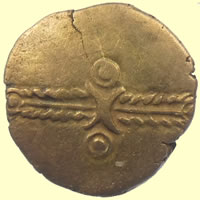 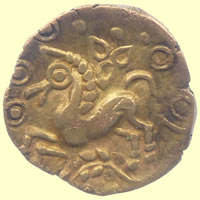 |
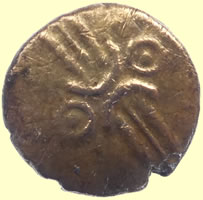 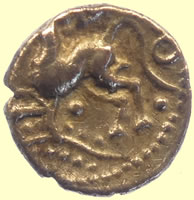 |
25BC Eastern uninscribed Celtic gold qtr stater of Dubnovellaunos - reported to museum 1.23g,13.27mm |
25 BC Celtic gold qtr stater, reported to museum Dubnovellaunus tribe Celtic gold qtr stater-11.0mm,1.35g Linear wreath, with opposed crescents; Horse left with branch below and trefoil design above |
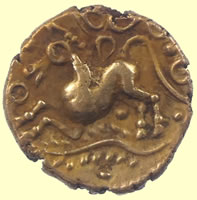 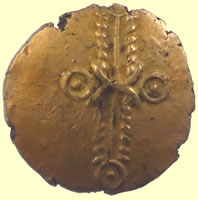 |
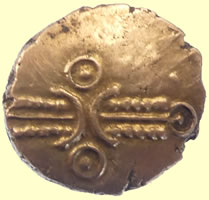 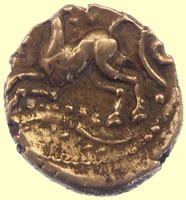 |
'Eastern uninscribed gold quarter stater of Dubnovellaunos, c 20 BC-AD 10. Van Arsdell VA1660 =BMC 2442. 12mm,1.28g- sent for recording on PAS |
25BC Eastern uninscribed Celtic gold qtr stater of Dubnovellaunos Reported to museum and CCI 1.32g,11.75mm |
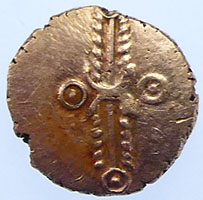 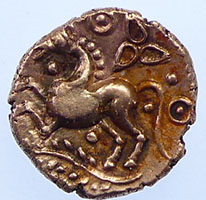 |
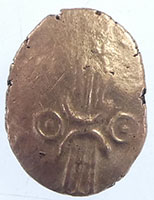 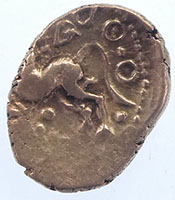 |
c. 20 BC-AD 10 Eastern uninscribed Celtic gold qtr stater of Dubnovellaunos 12.19mm,1.34g Dubnovellaunos in Essex quarter, VA 1660, BMC 2442, ABC 2395 |
Dubnovellaunos 25 BC to 5 AD Celtic gold qtr stater
1.35g, 13.19 mm |
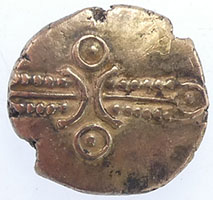 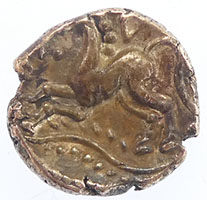 |
  |
1.33g, 10.57mm Dubnovellaunos 25 BC to 5 AD Celtic gold qtr |
Dubnovellaunos 25 BC to 5 AD Celtic gold qtr stater 1.24g, 12.38mm |
  |
  |
25BC Dubnovellaunus Celtic gold qtr stater 1.307g, 10.32mm Dubnovellaunos 25 BC to 5 AD |
25BC Dubnovellaunus Celtic gold qtr stater - reported to museum 1.37g, 12.52 mm Dubnovellaunos 25 BC to 5 AD |
Durotrigan
50 BC Celtic gold Durotrigan quarter 0.89g,11.86mm Durotrigan quarter, the exact type isn't in ABC but it's a variant of the standard ABC 2208 gold/electrum quarter but with one quadrant of the reverse stippled, probably dates to the 50s BC. I've called it the Stippled type in my forthcoming book, there are around 40 others known at present so not desperately rare; all the known provenances are in the Dorset/Hampshire/West Sussex region so an Essex find would be exceptional. All the best John PAS reference: ESS-FE6D45. |
|
60 - 50 BC Gallo Belgic
The first coins used in Britain were imported from Gaul from the 3rdC BC to the mid 1stC BC. The imported coins most frequently came from Gallia Belgica and called Gallo- Belic by numismatists.
|
|
 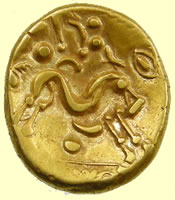 |
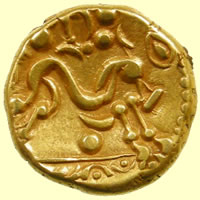 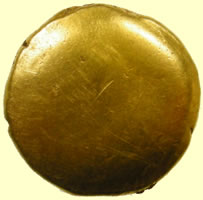 |
50 BC Gallo Belgic full Celtic gold stater 6.24g, 18.72mm A nice uniface stater, this is Scheers class 2, probably struck around 57-56 BC and one of the few Celtic coins that can be dated with some accuracy. I've recorded it as 13.0004.
All the best |
Beautiful strike of a 56 BC Gallo Belgic full Celtic gold stater sent to CCI for recording 16mm,6.28g 'the Gallo-Belgic E 'Gallic War uniface' stater is CCI 14.0530' John Sills |
 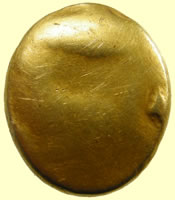 |
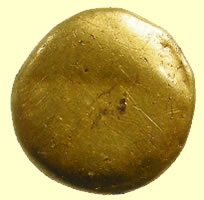 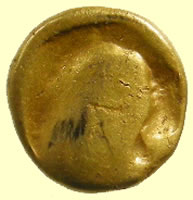 |
Gallo Belgic 50 BC Celtic gold full stater 6.35g, 17.74 Hi Chris
It's a nice early one, from a known reverse die, from near the start of Gallo-Belgic E class 1 so should date to c.57 BC as the series probably began soon after the start of the Gallic Wars in 58/7; CCI 12.0837.
John |
Continental Iron Age Gallo-Belgic DC uninscribed gold quarter state This is a scarce variant of Gallo-Belgic D, the Face type, Scheers seies 14, my Gallo-Belgic Cd. On one side there's a very worn 'boat' design and on the other a large, kidney shaped blob, also very worn, that looks like an outline face on other coins. In 2003 I suggested they were struck by eastern neighbours of the Ambiani, perhaps by the Viromandui; there were 13 known at the time, perhaps 20-25 now including several from Britain, although I don't have the cards here. I'll give it a number later with the next batch if that's OK with you, All the best John 1.60g, 9.43mm |
  |
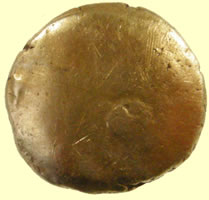  |
50BC Celtic gold 1/4 stater - probably Snettisham type 1.57g, 14.22mm Gallo-Belgic Aa quarter, probably my class 3 but too worn to be certain CCI 12.0364 |
50 BC Celtic gold full stater - Gallo Belgic 16.49mm, 6.05g Gallo-Belgic E stater, Scheers class 4. Standard example of the type, several hundred known CCI 12.0363 |
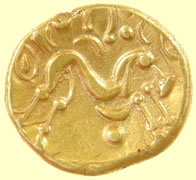 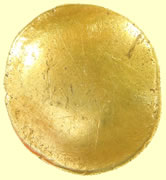 |
  |
| Gallo Belgic 50BC Celtic gold stater 6.38g, 16.96mm sent to CCI for recording | Gallo Belic 50 BC Celtic gold full stater 6.30g, 17.59mm CCI 08.9323 |
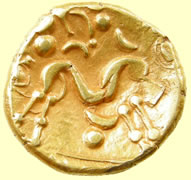 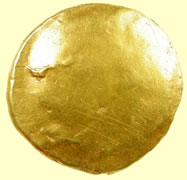 |
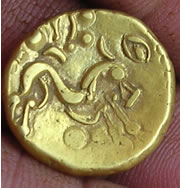  |
| 50Bc Gallo Belgic Celtic gold stater - 17.42mm, 6.19g CCI 08.9320 | 50BC Gallo Belgic Celtic gold stater 6.24g - 16.58mm 'This'll be CCI 06.0190. Difficult to say exactly which class of uniface stater it is with this amount of wear - indeed it's quite unusual to see one which is this worn, it looks as though it knocked about a bit before being lost/deposited'. |
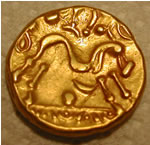 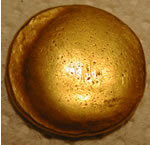 |
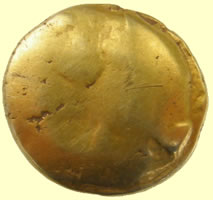 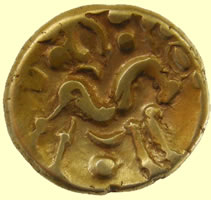 |
| Gallo-Belgic E stater, c. 56 BC. It's class 2 of the type, listed in Van Arsdell as VA 52. This will be 04.0476 in the CCI. | 50BC Gallo Belgic Celtic gold full stater - sent to CCI for recording 17.28mm - 6.00g I've recorded the Gallo-Belgic E as 13.0623. It's a class 4 coin and can be dated quite precisely, probably to around 55/54 BC; it's from a known reverse die, there are several others with this characteristic die flaw below the horse's body. Many thanks, John |
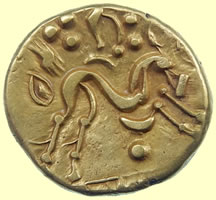 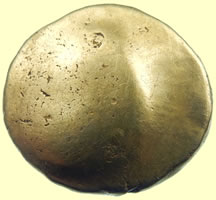 |
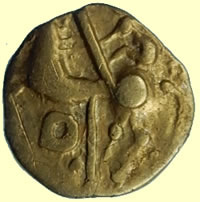 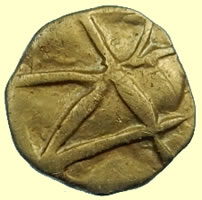 |
Beautiful strike of a 56 BC Gallo Belgic full Celtic gold stater - sent to PAS for recording 6.26g, 20 mm |
Mint condition - 50 BC Celtic gold Gallic import qtr stater - sent to PAS for recording Crossed lines with rider ABC 37, VA 37 Classed as scare 1.94g, 12 mm Caletes tribe, Normandy coast |
  |
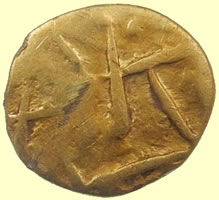 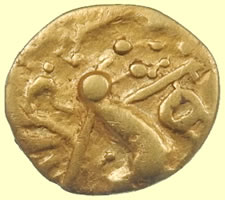 |
50 BC Celtic gold Gallic import qtr stater - new one for me - sent to PAS for recording Crossed lines with rider ABC 37, VA 37 Classed as scare 1.86g, 10.15mm Caletes tribe, Normandy coast |
0 BC Celtic gold Gallic import qtr stater - sent to PAS for recording Crossed lines with rider ABC 37, VA 37 Classed as scare Caletes tribe, Normandy coast |
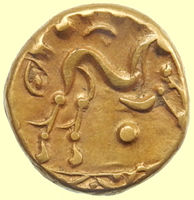  |
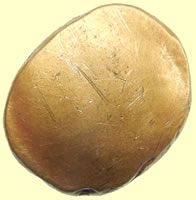 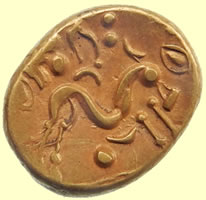 |
50 BC Gallo Belgic Celtic gold full stater- sent to PAS for recording 6.30g,17.7g |
50 BC Gallo Belgic Celtic gold full stater- sent to PAS for recording 6.18g, 17.2mm |
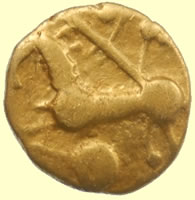 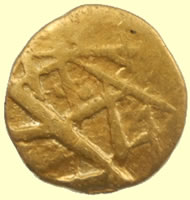 |
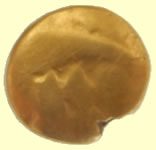 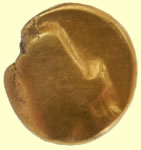 |
50 BC Celtic gold Gallic import qtr stater - sent to PAS for recording Crossed lines with rider ABC 37, VA 37 Classed as scare 1.86g, 10.15mm Caletes tribe, Normandy coast |
Smallest Celtic gold we have ever found Continental Iron Age Gallo-Belgic DC uninscribed gold quarter state This is a scarce variant of Gallo-Belgic D, the Face type, Scheers seies 14, my Gallo-Belgic Cd. On one side there's a very worn 'boat' design and on the other a large, kidney shaped blob, also very worn, that looks like an outline face on other coins. In 2003 I suggested they were struck by eastern neighbours of the Ambiani, perhaps by the Viromandui; there were 13 known at the time, perhaps 20-25 now including several from Britain, although I don't have the cards here. I'll give it a number later with the next batch if that's OK with you, All the best John 1.23g,8.82mm |
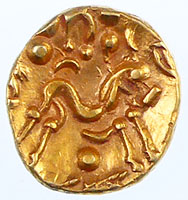 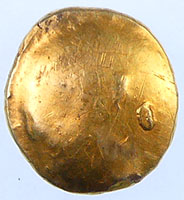 |
|
50 BC Gallo Belgic Celtic gold stater 6.11g,18.0 mm |
|
Ingoldisthorpe - Catuvellauni tribe
It is the earliest known coinage of the Catuvellauni, and immediately precedes the much commoner Westerham type. The dies for Ingoldisthorpe staters are of such high quality that they must have been cut by a Gaulish engraver; they mimic Gallo-Belgic C but with a range of additional motifs not seen on Belgic coinage until the Gallic Wars of the 50s BC. For this reason, and because the Ingoldisthorpe and Westerham series as a whole has all the hallmarks of an emergency coinage, they were probably struck to finance Cassivellaunus' campaign against Caesar in 54 BC. |
|
 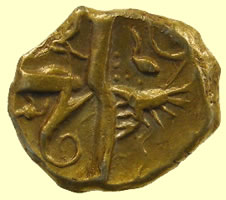 |
|
Stunning Celtic gold 1/4 stater- Unique animal design 1.45g,11.83mm A gold Iron Age quarter stater, Early Uninscribed British series O 'Geometric' type, c.100-50 BC. Obverse close to Hobbs no. 416; VA1225 CCI 12.0369 Ingoldisthorpe quarter, ABC 2448, not in VA or BMC. Another extremely rare type, good to have a reliable findspot, this one is from the same dies as ABC 2448 itself.
|
|
55-50 BC Celtic gold qtr stater - sent to museum for recording 1.51g,12.33mm It's a class 3 Great Waltham type quarter, no. 400 in Divided Kingdoms (same dies), essentially a slightly later and cruder version of the Ingoldisthorpe quarter, which is class 2 in the British Ab/Ac north-east Thames series. I list 14 other examples in DK but there are at least 15 now. Hope this is of some help, All the best John
1.45g,11.96mm It's a class 3 Great Waltham type quarter, no. 400 in Divided Kingdoms (same dies), essentially a slightly later and cruder version of the Ingoldisthorpe quarter, which is class 2 in the British Ab/Ac north-east Thames series. I list 14 other examples in DK but there are at least 15 now. Hope this is of some help, All the best John |
|
Morini
|
|
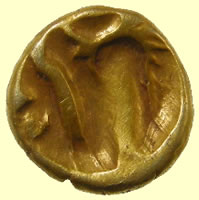  |
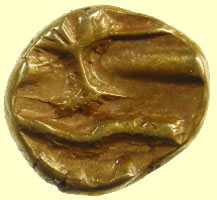 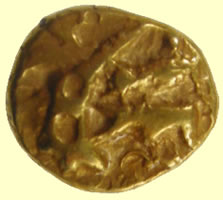 |
This looks like a 70BC Morini boat tree Celtic gold qtr stater but it could be another very rare North Thames type based on Gallo-Belgic D Boat Tree quarters 1.51g,10.18mm |
10.35mm, 1.46g 70BC Morini boat tree Celtic gold qtr stater - reported to museum as hoard and sent to CCI for recording The latest Gallo-Belgic D quarter 12.0857; it looks like there should be quite a few more given that half a dozen have come up in fairly rapid succession. This type of hoard is extremely useful because the Gallo-Belgic gold can be dated quite closely so it helps to date the start of British coinage.
All the best John |
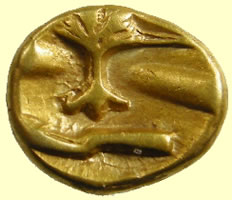  |
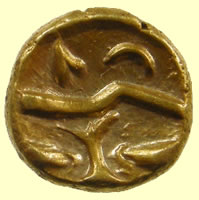 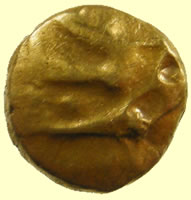 |
70BC Morini Boat Tree type Celtic gold qtr stater - sent to CCI for recording 1.49g, 10.40mm Reported as hoard to museum |
70BC Morini Boat Tree type Celtic gold qtr stater - sent to CCI for recording 1.45g, 9.63mm Reported as hoard to museum |
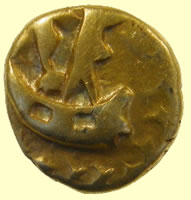 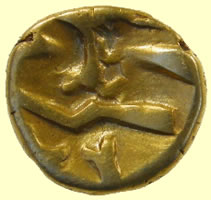 |
 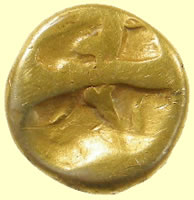 |
70 BC Morini 'boat tree' Celtic qtr stater Gallo-Belgic D ‘boat type’ quarter, Scheers class 3 CCI 12.0366 |
A Continental Iron Age Gallo-Belgic DC uninscribed gold quarter stater, Gallo-Belgic DC , dating circa 70-50 BC. VA 69-1. 1.60g, 9.23mm Gallo-Belgic D quarter (my G-B Ca). Probably my class 3, obverse worn flat CCI 12.0365 |
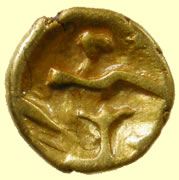 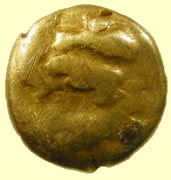 |
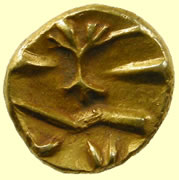 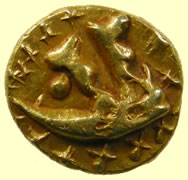 |
| 70BC Morini Celtic 'boat tree' gold qtr stater - Sent to CCI for recording 1.41g, 10.81mm | 70BC Morini Celtic 'boat tree' gold qtr stater - Sent to CCI for recording Very interesting example being the lightest we have ever found and the smallest diameter. Normal weight range of a Morini is 1.41-1.45g Also a very different die type so it will be interesting to see the comments from the CCI experts 1.23g, 9.22mm |
  |
  |
70BC Morini Celtic 'boat tree' gold qtr stater - Sent to CCI for recording 1.45g, 10.80mm |
70BC Morini Celtic gold qtr stater - Sent to CCI for recording 1.48g, 10.86mm Gallo-Belgic Dc gold quarter stater. “Morini”, c. 60-50 BC. “Boat” and “tree” like designs Delestree & Tache 249, VA 69-1, Scheers 13, pl. 5.115-117. These are obviously pretty common finds all along the Thames/SE. Ian |
  |
  |
70BC Morini Celtic gold qtr stater - Sent to CCI for recording 1.44g,10.27mm CCI number 10.0887 |
70BC Morini 'boat tree' type Celtic gold 1/4 stater 1.48g, 10.28 mm |
  |
  |
70BC Morini 'boat tree' type Celtic gold 1/4 stater 1.46g, 11.33 mm
2.87g, 26.93mm |
70BC Morini 'boat tree' Celtic gold qtr stater - sent to CCI for recording 11.07mm, 1.48g Thanks for this, what a good start to the season! I think it's still stars - it would be nice to think that it's an This'll be CCI 08.9087. |
  |
  |
| 70BC Morini 'boat tree' Celtic gold 1/4 stater 1.48g, 11.87 mm - CCI 07.0123 | 70BC Morini 'boat tree' Celtic gold 1/4 stater 1.45g, 11.61mm - CCI 06.0187 'The G-B quarter is a lovely coin, looks very sharp. There is a distinctive class of these which have all the little crosses around the 'boat' - they're not uncommon, but not always as nice as this'. |
  |
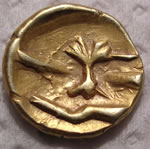 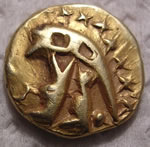 |
| Morini
' boat tree' type c 70BC Celtic quarter stater 1.41g, 11.0 mm
CCI 05.0751 |
Morini ' boat tree' type c 70BC Celtic quarter stater - 1.45g 11mm |
  |
  |
| Celtic quarter Morini boat tree 70 BC | Celtic quarter Morini boat tree 70 BC '6th hoard coin' quarter with two lines on the reverse rather than the usual tree pattern, 1.45g, is 13.0075 |
  |
  |
70BC Morini Boat Tree type Celtic gold qtr stater - sent to CCI for recording 1.45g,12.54mm Reported as hoard to museum 13.0669 - Gallo-Belgic D quarter no. 2 (1.45g), this is the 'Y' or Branch type, not in ABC, very slightly earlier than the standard type, say 57 BC, quite scarce although more are turning up. Struck from a worn reverse die where the central line has developed a long flaw that makes it look like a branch. |
70BC Morini Boat Tree type Celtic gold qtr stater - sent to CCI for recording 1.46g, 11.41mm Reported as hoard to museum 13.0668 - Gallo-Belgic D quarter no. 1 (1.46g), ABC 40 type struck early in the Gallic Wars, around 56 BC or so. |
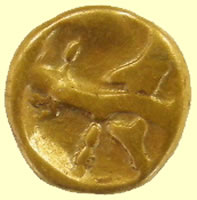 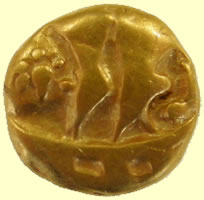 |
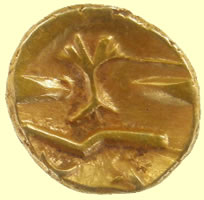 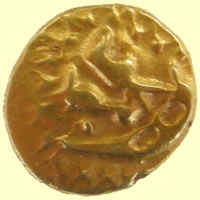 |
70BC Morini Celtic gold 'boat tree' qtr stater - reported to museum as hoard 1.49g, 9.97mm (E) |
70BC Morini Celtic gold 'boat tree' qtr stater - reported to museum as hoard 1.46g, 11.06mm (J) |
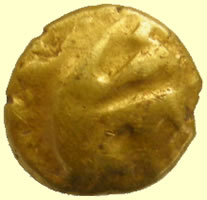 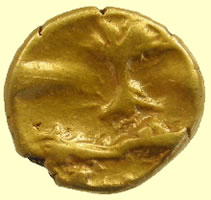 |
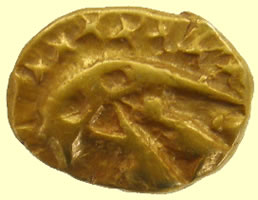 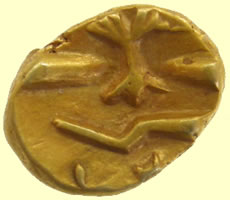 |
70BC Morni Celtic gold qtr stater reported to museum as haord 1.45g, 10.38mm |
70BC Morini Celtic gold qtr stater - sent to CCI for recording and reported as hoard to museum 1.46g, 11.55mm |
  |
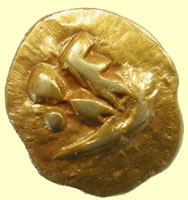 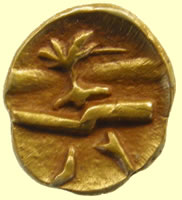 |
70BC Morini Celtic gold qtr stater - sent to CCI for recording and reported as hoard to museum 1.45g, 10.75mm |
70BC Morini Celtic gold qtr stater - sent to CCI for recording and reported as hoard to museum 1.14g, 11.52mm |
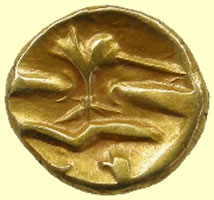 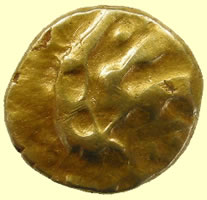 |
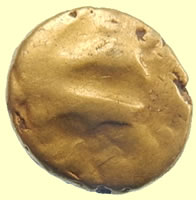 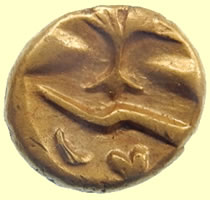 |
70BC Celtic gold Morini qtr gold stater- sent to CCI for recording and reported as hoard addendum to museum 1.47g,11.27mm dia The Gallo-Belgic D 'boat type' quarter you sent through in February is CCI 14.0529 John Sills |
70BC Morini Celtic gold qtr - sent to PAS for recording 1.51g, 10.5mm |
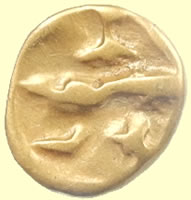 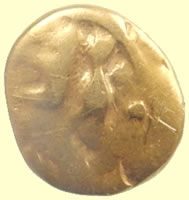 |
  |
70 BC Morini Celtic gold qtr stater 1.46g,10.27mm Reported to museum as hoard |
70BC Morini Celtic gold qtr - sent to PAS for recording 1.39g,11mm |
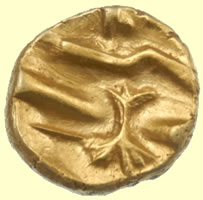 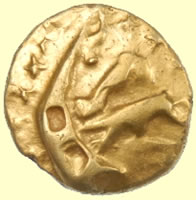 |
  |
70BC Morini Boat Tree type Celtic gold qtr stater - hoard addendum coin reported to museum 1.50g, 10.00mm |
70 BC Morini Celtic gold qtr stater ? Is this one of those rare English types and not a Morini ? - reported as hoard addendum to museum 0.76g, 10.19mm CCI 19.1419
|
  |
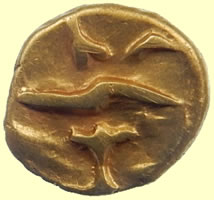 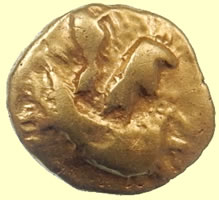 |
70 BC Morini Celtic gold qtr stater- reported as hoard addendum to museum 1.47g,10.79g CCI 19.1420. |
70BC Celtic gold qtr stater - sent to PAS for recording 1.44g, 10.8mm |
  |
  |
70 BC Morini Celtic qtr stater - reported to PAS for recording 1.41g, 9.9mm |
An Iron Age uninscribed gold quarter stater of Sills’ insular Af2 type, dating to the period 80-60 BC. Coins of this type are derived from the Gallo-Belgic DC quarter stater but produced locally in South-Western Britain in the coinage area traditionally associated with the Durotriges. The British type seems to have a higher silver content and lower gold content than the Gallo-Belgic types. Obverse: Boar, left. Reverse: Abstract geometric design with one stippled quadrant. The coin is damaged on one side. Dimensions: Weight: 0.9g. Diameter: 11.8mm. |
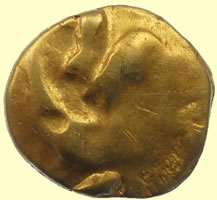 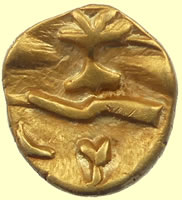 |
|
70BC Morini Celtic gold qtr stater - sent to museum for recording 11mm,1.48g |
|
50 BC Norfolk wolf type - Iceni tribe
Julius Caesar described the Iceni as Cenimagni, who surrendered to him during his second expedition to Britain in 54 BC. The Cenimagni may have been a branch of the Iceni or it could be a corruption of Iceni Magni meaning "Great Iceni". |
|
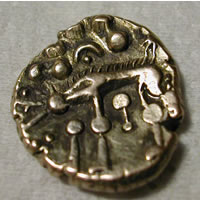 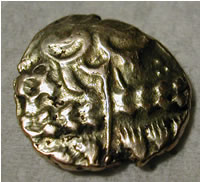 |
|
Celtic gold stater Norfolk wolf type 65-45 BC 'CCI No 04.0681 is the Norfolk wolf. Another nice coin, c. 50 BC. The basic type is common (over 300 coins) but there are minor variations in the design, and this appears to be a rare variant with a sort of stick below the wolf rather than the usual crescent and pellet. I haven't checked through all the records but from memory there are no more than half a dozen or so from this die variant'. |
|
| North Thames - these include the Catuvellauni & Trinovantes | |
  |
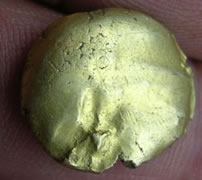  |
Celtic gold stater 16.76mm,5.89g - sent to CCI for recording 'This is quite a rare type, as you no doubt appreciate. The best parallel is provided by three coins in the British Museum, listed in their catalogue as nos. 3353-55. It's one of a group of coins loosely described as the Snettisham staters, because several of the types were first recognized in one of the Snettisham (Norfolk) hoards of the early 1990s. The exact type is not in Van Arsdell although it's closely related to the North Thames types listed as VA 1500, 1502 and thereabouts. It is presumably an East Anglian type, although because of the stylistic similarities there must have been some very strong link between the producers of the Snettisham types and the North Thames types. Date c. 50 - 40 BC, I think. |
Interesting Celtic gold find - it appears to be the first right facing Dubnovellaunus Late 1st BC to Early 1stC AD Full Celtic gold stater found here 5.73g, 17.13mm 'This is quite a rare type, as you no doubt appreciate. The best parallel is provided by three coins in the British Museum, listed in their catalogue as nos. 3353-55. It's one of a group of coins loosely described as the Snettisham staters, because several of the types were first recognized in one of the Snettisham (Norfolk) hoards of the early 1990s. The exact type is not in Van Arsdell although it's closely related to the North Thames types listed as VA 1500, 1502 and thereabouts. It is presumably an East Anglian type, although because of the stylistic similarities there must have been some very strong link between the producers of the Snettisham types and the North Thames types. Date c. 50 - 40 BC, I think. I'll record it as CCI 07.1164. '
|
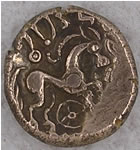 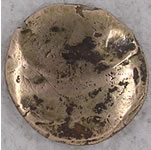 |
  |
North Thames type Celtic gold stater 5.54g - 16.93 'many thanks for this one, a rare one indeed. It's an example of VA 1509, also in the BM catalogue (BMC 350) and no. 34 in 'Coins of England'. It usually has a couple of S shapes on the obverse, although I can't see any traces of them here - the obverse is sometimes worn though. It seems to be a North Thames type, to judge from the few provenances available, but there are only six examples previously recorded so it is a rare type. I would guess quite early too, perhaps 40s BC. Certainly one of the best Celtic you've had so far, thanks! It'll be CCI 06.0195'. |
1/4 Uninscribed Celtic gold stater 1.43g, 12.98mm 'Yes, this is interesting. It's an uninscribed quarter stater, traditionally attributed to the Atrebates (in the South Thames) but almost certainly a North Thames issue. We have records of about 25 of them, and without exception they've come from the North Thames area: it was previously attributed to the Atrebates because of the style, which resembles their uninscribed quarter staters with a wreath on the obverse. The date of this quarter would be around c. 45 BC, I would estimate, so like the Whaddon Chase it could be just a little earlier than the Addedomaros coins. It is catalogued in Van Arsdell as VA 260-1, but not only wrongly as Atrebates but also listed as silver. Many of the surviving examples are struck from the same pair of dies, which develop some fairly major flaws, especially on the reverse; the lack of many dies suggests this wasn't a very big issue, in comparison to the Addedomaros spiral for example. If I remember rightly there are one or two examples of this type in the huge East Leicestershire hoards which came up about 3 years ago, but mostly they're Essex/Suffolk area. This'll be CCI 05.0683'. |
  |
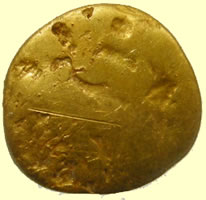 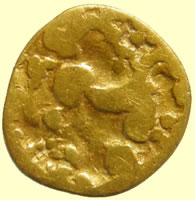 |
Not a 70 BC Celtic Morini boat tree qtr gold stater as I first thought - rare North Thames type 1.48g, 10.58mm This coin is an important find because although it's a type based on Gallo-Belgic D Boat Tree quarters it's an early British copy, ABC 2454, from the same dies as the one illustrated in the book. Although ABC says it's excessively rare there are actually around 20 known, but there are very few reliable findspots and this one helps to confirm it's a North Thames type. I've recorded it as 13.0002 (got some new numbers through at last). All the best John |
Very interesting Celtic gold qtr gold stater - sent to CCI for ID and recording Reminds me of a 50BC North Thames type 1.54g, 13.51mm dia |
'Remi
Their capital was at Durocortum (Reims, France) the second largest oppidum of Gaul on the Vesle. Allied with the Germanic tribes of the east, they repeatedly engaged in warfare against the Parisii and the Senones.They were renowned for their horses and cavalry. |
|
  |
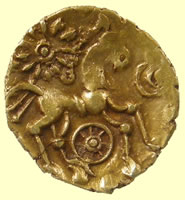 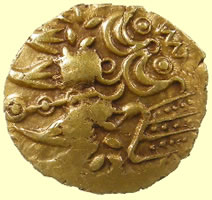 |
Early 70BC uninscribed 'Q' Gold - 'Remi 'Type Celtic gold qtr stater 1.35g, 12.24mm Maldon Wheel quarter, not in VA or BMC, ABC 2234. Extremely rare, 12 others known, struck from known dies but from a new die combination so a very useful coin to have, especially with a reliable provenance. CCI 12.0378 |
Early 70BC uninscribed 'Q' Gold - 'Remi 'Type Celtic gold qtr stater Rev .horse r.,from nrck pellet ring var.d above pellet in ring,flower j & pellet-in-ring,before 4 pellet-in-rings,below wheel f & pellet, below & above tail pellet-in-ring triangle 1.34g,14.86mm Hobbs 482 |
  |
  |
70 BC Remi tribe Celtic gold 1/4 stater - sent to CCI for recording and ID 1.14g,12.55mm |
50 BC 1/4 Celtic gold stater 14.32mm, 1.36g Similar to a Southern Commios tribe |
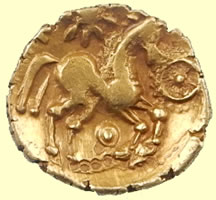 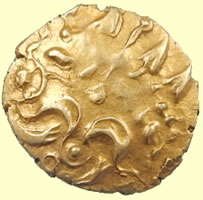 |
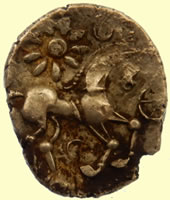 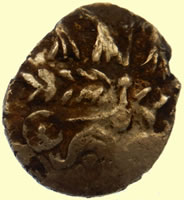 |
Early 70BC uninscribed 'Q' Gold - 'Remi 'Type Celtic gold qtr stater - sent to PAS for recording 1.35g,13.74mm |
Early 70BC Maldon Wheel quarter - 'Remi 'Type Celtic gold qtr stater - sent to PAS for recording 13.45mm,1.34g |
  |
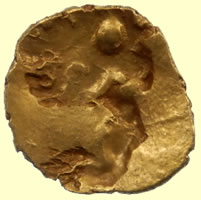 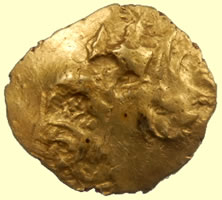 |
50 - 20 BC Essex Wheels quarter, VA 260, BMC 485 and 496, ABC 2231 - sent to museum for recording 1.41g,15.1mm |
50 - 20 BC Essex Wheels quarter, VA 260, BMC 485 and 496, ABC 2231 1.38g,14mm |
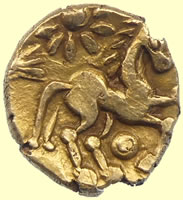 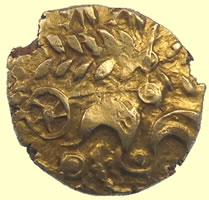 |
 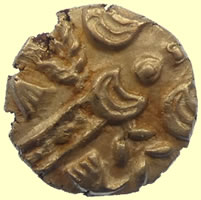 |
Early 70BC uninscribed 'Q' Gold - 'Remi 'Type Celtic gold qtr stater Possible Maldon wheel - reported to museum and CCI 1.33g,11.61mm |
70BC Remi Celtic gold qtr stater - reported to museum and CCI for recording 1.13g,10.00mm |
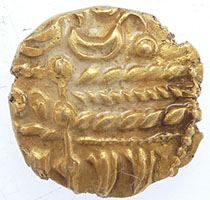 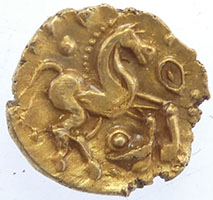 |
|
1.26g,12..33mm 70BC uninscribed 'Q' Gold - 'Remi 'Type Celtic gold qtr stater |
|
Essex Wheels type - Trinovantian |
|
  |
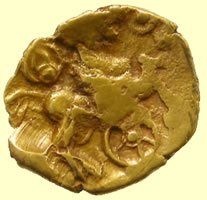 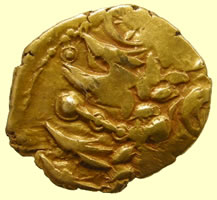 |
50 - 20 BC Essex Wheels quarter, VA 260, BMC 485 and 496, ABC 2231. Quite a rare Trinovantian type 1.4g, 14.42mm - sent to CCI for recording and ID confirmation. |
14.65mm,1.39g Essex Wheels quarter, VA 260, BMC 485 and 496, ABC 2231. Quite a rare Trinovantian type, two others from this pair of dies.
CCI 12.0371 |
  |
|
The second is an Eastern uninscribed gold quarter stater, type attributed to the Trinovantes, struck c 50-20 BC.
VA 260 = BMC (Hobbs) 485 and 496.
These are interesting as they are clearly of Southern style (Atrebates etc), but are an Eastern or North Thames (Trinovantes etc) type as the distribution of findspots seems to show.
I have records of 20 provenanced examples of these (including 12 Essex and 4 suffolk)
I have given this the number 10.0888
Ian |
Very interesting 70 BC Tring Wheel looking Celtic gold stater , cogged sun type. No exact die type in Hobbs or Rudd.Sent to PAS for recording 12.64mm,1.27g 40-30 BC Trinovantes Rowntree Fern leaf Celtic gold qtr stater |
|
Big Wheel Type Middle Whaddon Chase gold stater, so named on account of the large spoked chariot wheel (representing the sun) which is under the spritely horse. |
|
  |
  |
50 BC Middle Whaddon Chase stater Celtic gold full stater 5.45g, 17.21mm Obv cross of 3 plain & 2 pellet lines with 2 opposed crescents b in centre Rev horse r ., above pellet in ring, pellet in wheel below Middle Whaddon Chase stater, VA 1491, BMC 343, ABC 2240. An extremely rare type, only 7 others known, very nice to see another one. This one seems to be from the same obverse die as 95.2630, same rev as CR 116, 2011, no. 32. Reverse similar to early staters of Addedomaros but an uninscribed type, much rarer. CCI 12.0368 |
1stC BC Uninscribed 'L' 'Waddon Chase type' Celtic gold full stater - sent to CCI for recording 5,86g, 1.6mm 'These coins are probably not very much earlier than the Addedomaros staters - it all depends really on when one dates the Addedomaros issue. It seems fairly certain that the Whaddon Chase staters could be from the later stages of the Gallic War, say about 54 BC at the earliest; they could be a little bit later, but are unlikely to be after say 40 BC at the very latest.' Dr Philip de Jersey |
  |
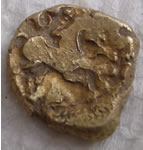 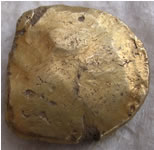 |
Celtic gold qtr stater 13.56,1.29mm Eastern uninscribed gold quarter stater (attributed to the Trinovantes), c.50-20 BC (This type is called “Heybridge Horse” by Chris Rudd). Not in Van Arsdell or BM catalogue. |
'Snettisham' type ? Celtic gold full stater 5.85g - 17.05mm 'Having seen this one I've had to think again about 05.0680, the Whaddon Chase type I wrote about earlier. Although quite different in their individual style these are probably both the same variety of WC stater, actually listed as VA 1498. This is a rather puzzling type because it's not clear whether it really belongs to the WC group or - as you suggested - the Snettisham type. There are 18 examples of it here and those with findspots are a mixture of Essex, Suffolk and Norfolk - on that basis it could arguably be either WC or Snettisham. In terms of style, they are perhaps among the very last WC staters rather than being the first Snettisham, which appear to have been based on the Whaddon Chase design. In terms of date this might only be a difference of a few months, and almost certainly not more than a few years, so it's perhaps unreasonable to expect we'll be able to tie it down quite so neatly. CCI 05.0687'. |
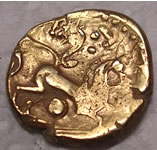 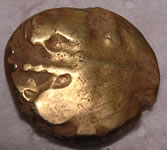 |
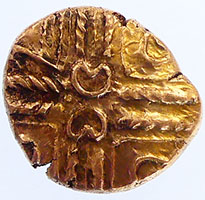 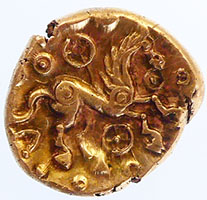 |
Celtic gold stater 'Whadden Chase' type 5.95g, 17.68 mm The Whaddon Chase stater (yes, it is that type) will be CCI 05.0680. These coins are probably not very much earlier than the Addedomaros staters - it all depends really on when one dates the Addedomaros issue. It seems fairly certain that the Whaddon Chase staters could be from the later stages of the Gallic War, say about 54 BC at the earliest; they could be a little bit later, but are unlikely to be after say 40 BC at the very latest. If Addedomaros's spiral staters are his latest stater issues, then they could be somewhere around 30-25 BC, so perhaps up to 25 years later than Whaddon Chase. It just depends where each type fits, and we don't have an exact idea. I suppose it's true to say though that there is almost certainly a minimum of ten years between them, and more likely 20. One of my colleagues recently suggested that the WC staters were issued by Cassivellaunus, to pay off Caesar during the Gallic War. They certainly seem to be found mostly in the territory of the Catuvellauni (so this one would be a bit further east than usual . The main catalogue reference for this type is VA 1476 in Van Arsdell's 'Celtic Coinage of Britain'. They're relatively common (300 or so recorded) but a lot of these are finds from the original WC hoard, found in Bucks in 1849. |
50 BC Middle Whaddon Chase stater Celtic gold full stater Obv cross of 3 plain & 2 pellet lines with 2 opposed crescents b in centre 5.47g,18.21mm |
  |
  |
Very rare Heybridge Horse type Celtic gold qtr stater - Trinovantes tribe c50-BC Wreath between two pellet lines,stylised locks of hair above, crescents and pellet ring motifs below Horse r,large rump,various pellets around, pellet boss below ABC 2359 Extemely rare 1.25g, 12.88mm Reported to museum |
Heybridge Horse type Celtic gold qtr stater - Trinovantes tribe c50-BC - reported to museum 1.25g, 11.2mm |
| Unique Celtic gold coin | |
One of a kind Celtic gold 1/4 stater Latest views from the experts "it's
an early (perhaps c. 50-40 BC) quarter stater, possibly produced in
Essex. This particular type is unpublished in any major catalogue,
Debased gold coin - Celtic blank 0.88g,9.07mm |
|
 |
|
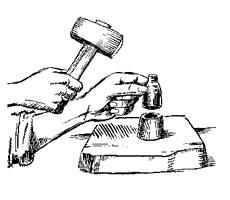

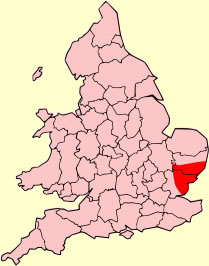 The Trinovantes or Trinobantes were one of the Celtic tribes of pre-Roman Britain. Their territory was on the north side of the Thames estuary in current Essex and Suffolk, and included lands now located in Greater London. They were bordered to the north by the
The Trinovantes or Trinobantes were one of the Celtic tribes of pre-Roman Britain. Their territory was on the north side of the Thames estuary in current Essex and Suffolk, and included lands now located in Greater London. They were bordered to the north by the 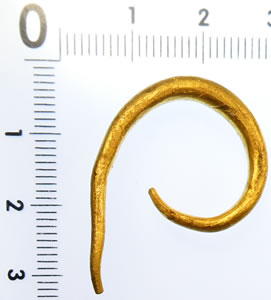
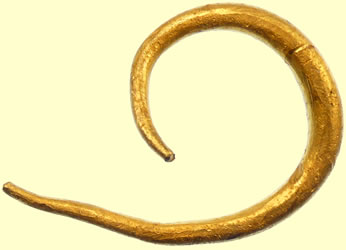

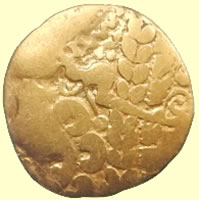






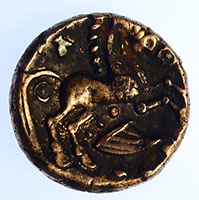
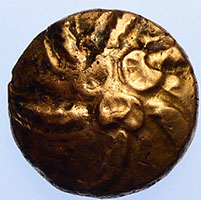


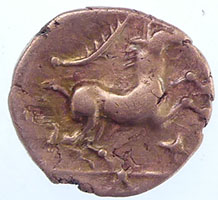
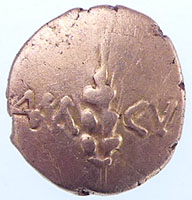
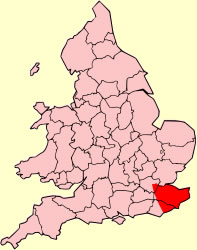 The Cantiaci or Cantii were a Celtic people living in Britain before the Roman conquest, and gave their name to a civitas of Roman Britain. They lived in the area now called Kent, in south-eastern England. Their capital was Durovernum Cantiacorum, now Canterbury.
The Cantiaci or Cantii were a Celtic people living in Britain before the Roman conquest, and gave their name to a civitas of Roman Britain. They lived in the area now called Kent, in south-eastern England. Their capital was Durovernum Cantiacorum, now Canterbury.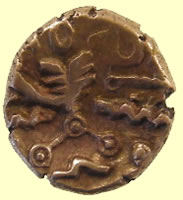
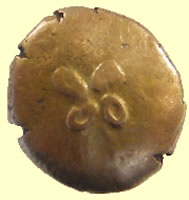
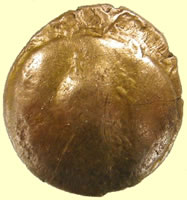
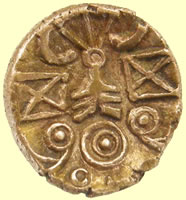


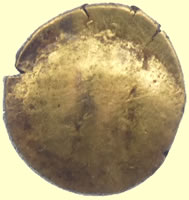
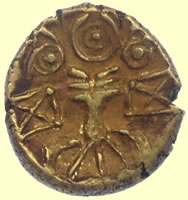




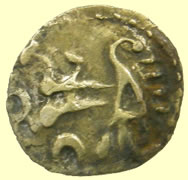
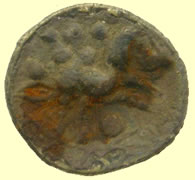
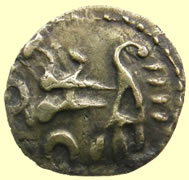
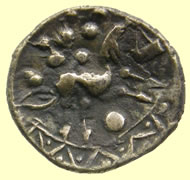
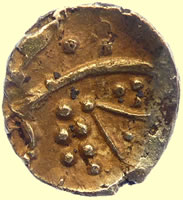
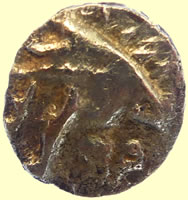
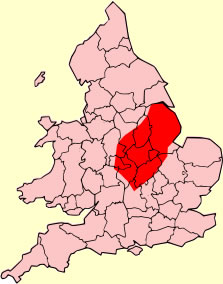 The Corieltauvi (formerly thought to be called the Coritani, and sometimes referred to as the Corieltavi) were a tribe of people living in Britain prior to the Roman conquest, and thereafter a civitas of Roman Britain. Their territory was in what is now the English East Midlands, in the counties of Lincolnshire, Leicestershire, Nottinghamshire, Derbyshire, Rutland and Northamptonshire. They were bordered by the Brigantes to the North, the Cornovii to the West, the Dobunni and Catuvellauni to the South, and the Iceni to the East. Their capital was called Ratae Corieltauvorum, known today as Leicester.
The Corieltauvi (formerly thought to be called the Coritani, and sometimes referred to as the Corieltavi) were a tribe of people living in Britain prior to the Roman conquest, and thereafter a civitas of Roman Britain. Their territory was in what is now the English East Midlands, in the counties of Lincolnshire, Leicestershire, Nottinghamshire, Derbyshire, Rutland and Northamptonshire. They were bordered by the Brigantes to the North, the Cornovii to the West, the Dobunni and Catuvellauni to the South, and the Iceni to the East. Their capital was called Ratae Corieltauvorum, known today as Leicester.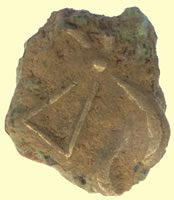
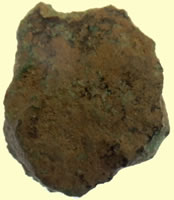
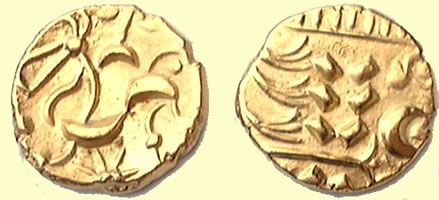
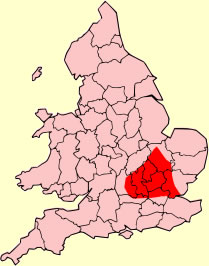 Cunobelinus appears to have taken power around 9 AD, minting coins from both Camulodunum (Colchester, capital of the Trinovantes) and Verlamion (later the Roman town of Verulamium, now modern St Albans), capital of the Catuvellauni. Some of the Verulamium coins name him as the son of Tasciovanus, a previous king of the Catuvellauni; unlike his father's, his coins name no co-rulers
Cunobelinus appears to have taken power around 9 AD, minting coins from both Camulodunum (Colchester, capital of the Trinovantes) and Verlamion (later the Roman town of Verulamium, now modern St Albans), capital of the Catuvellauni. Some of the Verulamium coins name him as the son of Tasciovanus, a previous king of the Catuvellauni; unlike his father's, his coins name no co-rulers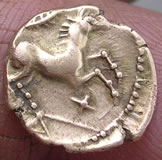
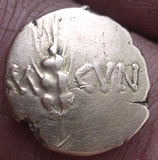
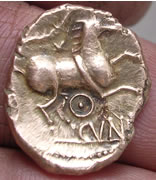
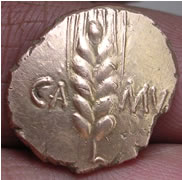




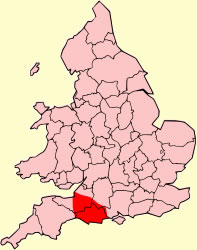
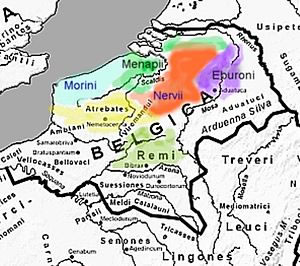
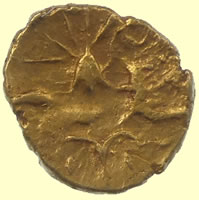
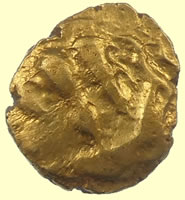


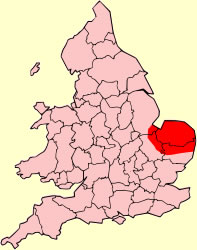 The Icenior Eceni were a tribe a part of Britannia or Britain who inhabited an area corresponding roughly to the modern-day county of Norfolk from the 1st century BC to the 1st century AD. They were bordered by the Corieltauvi to the west, and the Catuvellauni and Trinovantes to the south. The tribe turned into a civitas during the Roman occupation of Britannia. Their capital was Venta Icenorum.
The Icenior Eceni were a tribe a part of Britannia or Britain who inhabited an area corresponding roughly to the modern-day county of Norfolk from the 1st century BC to the 1st century AD. They were bordered by the Corieltauvi to the west, and the Catuvellauni and Trinovantes to the south. The tribe turned into a civitas during the Roman occupation of Britannia. Their capital was Venta Icenorum.

